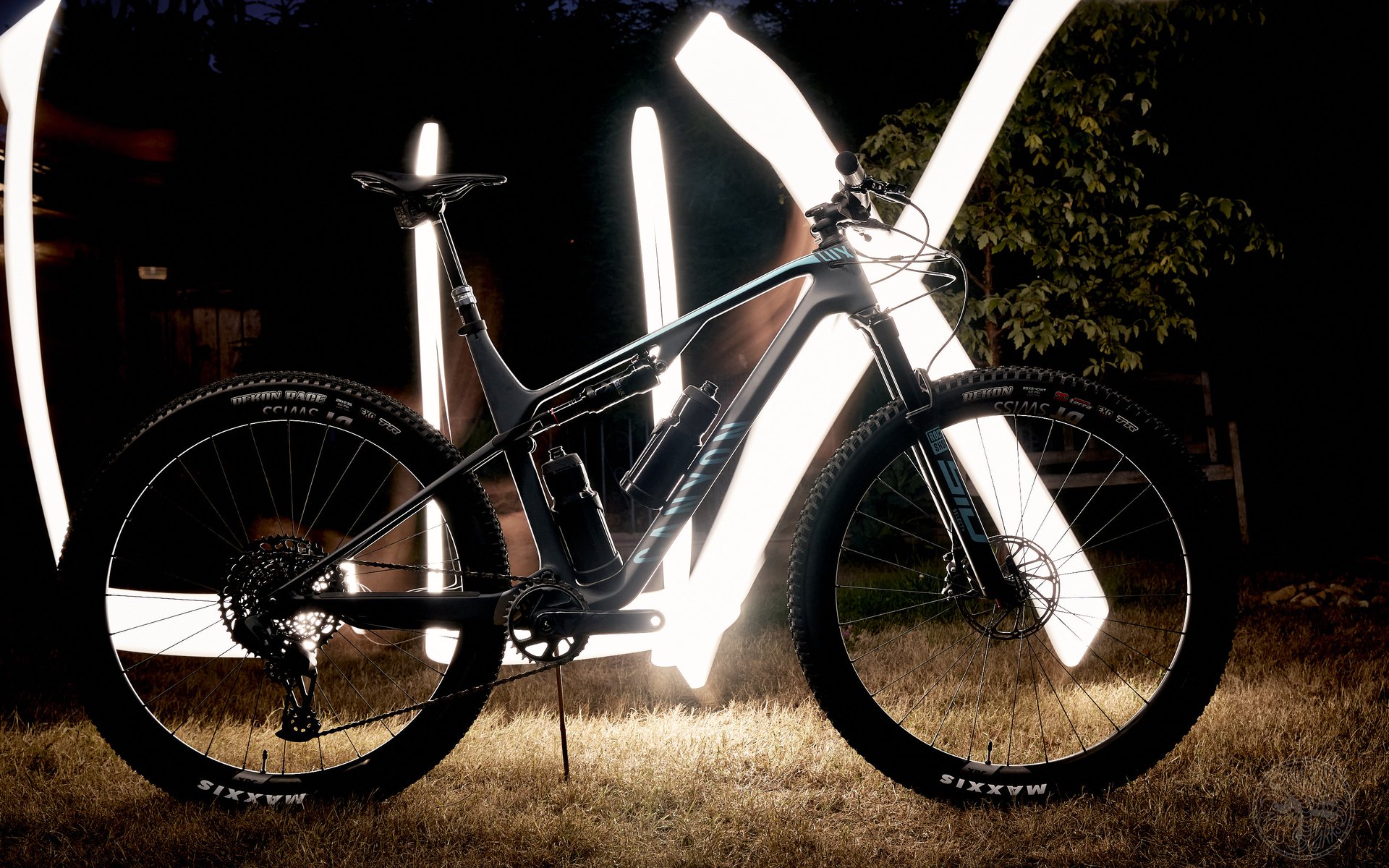
FIRST IMPRESSIONS
2022 Canyon Lux Trail
De Lux
Despite the descent-focussed marketing, the Lux Trail is Canyon's XC-friendly trail bike, or trail-friendly XC bike. The World Cup XC courses now feature somewhat technical trails, and it's genuinely faster to race a lot of them on a full-suspension bike, and Canyon has a purpose-built bike, in the Lux CF for that application. The bike I've signed up to review is the new Lux Trail which takes DNA from that bike, lengthens the Reach, slackens the head tube angle a bit, and beefs up the components to survive a more daily-driver, jack-and-jill-of-all-trades, riding style.
In my mind, this is the mountain biking of my youth. You could race it XC, you could race it DH, (though a few purpose-built DH bikes were starting to show up) and you could ride it anywhere and any way you wanted. As long as you changed the tires.
My goal for this review is to take a bike that's billed as "Light. Fast. Capable." with a claimed focus on descending prowess, and change the minimum number of components to add 'Fun!' to that list, specifically for riding "Tech-C trails" here on the North Shore.
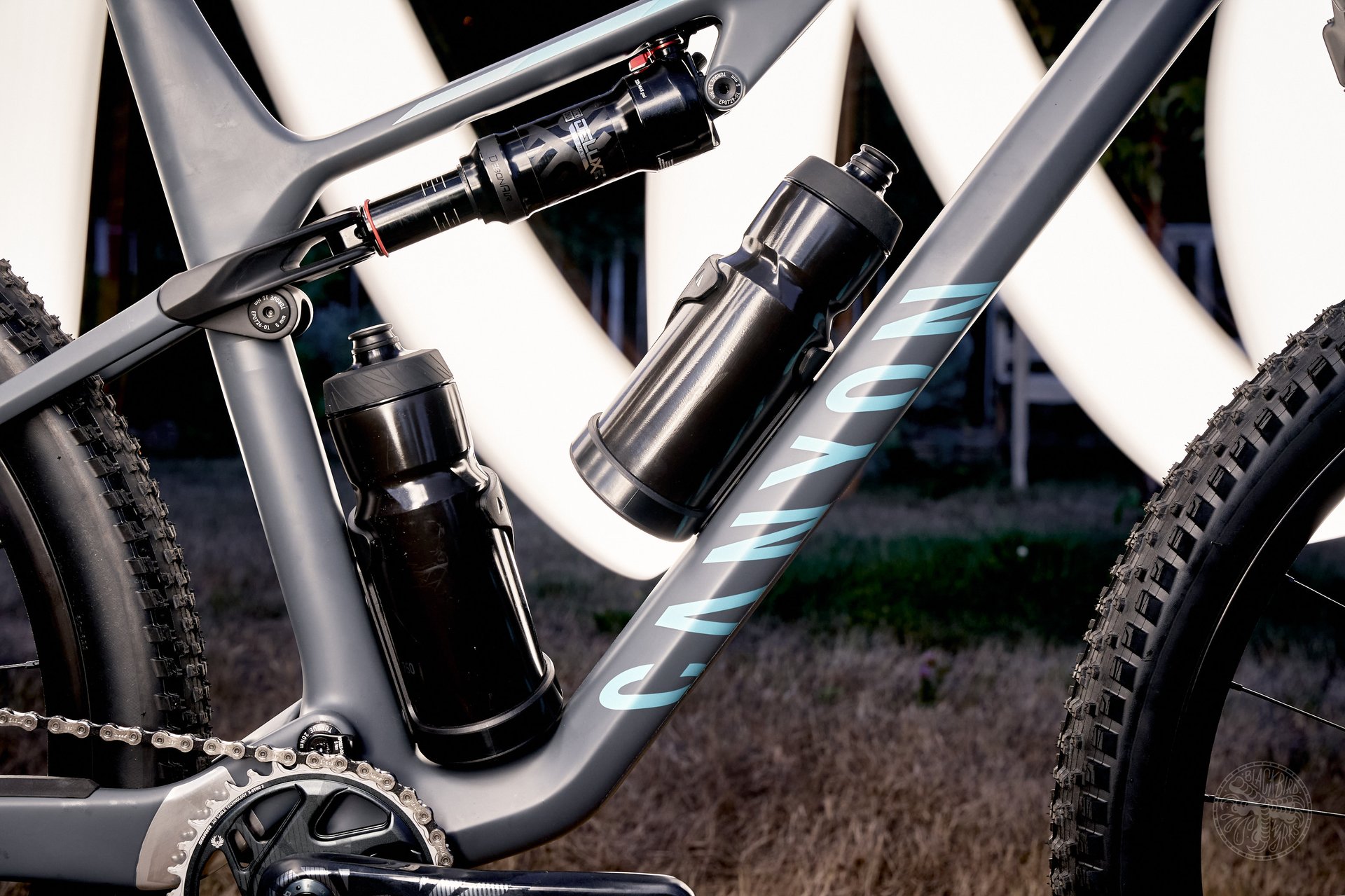
The Lux Trail is a very clean looking carbon bike, even accounting for the remote lockout cables. Two 750ml water bottles fit without issue in the main triangle.
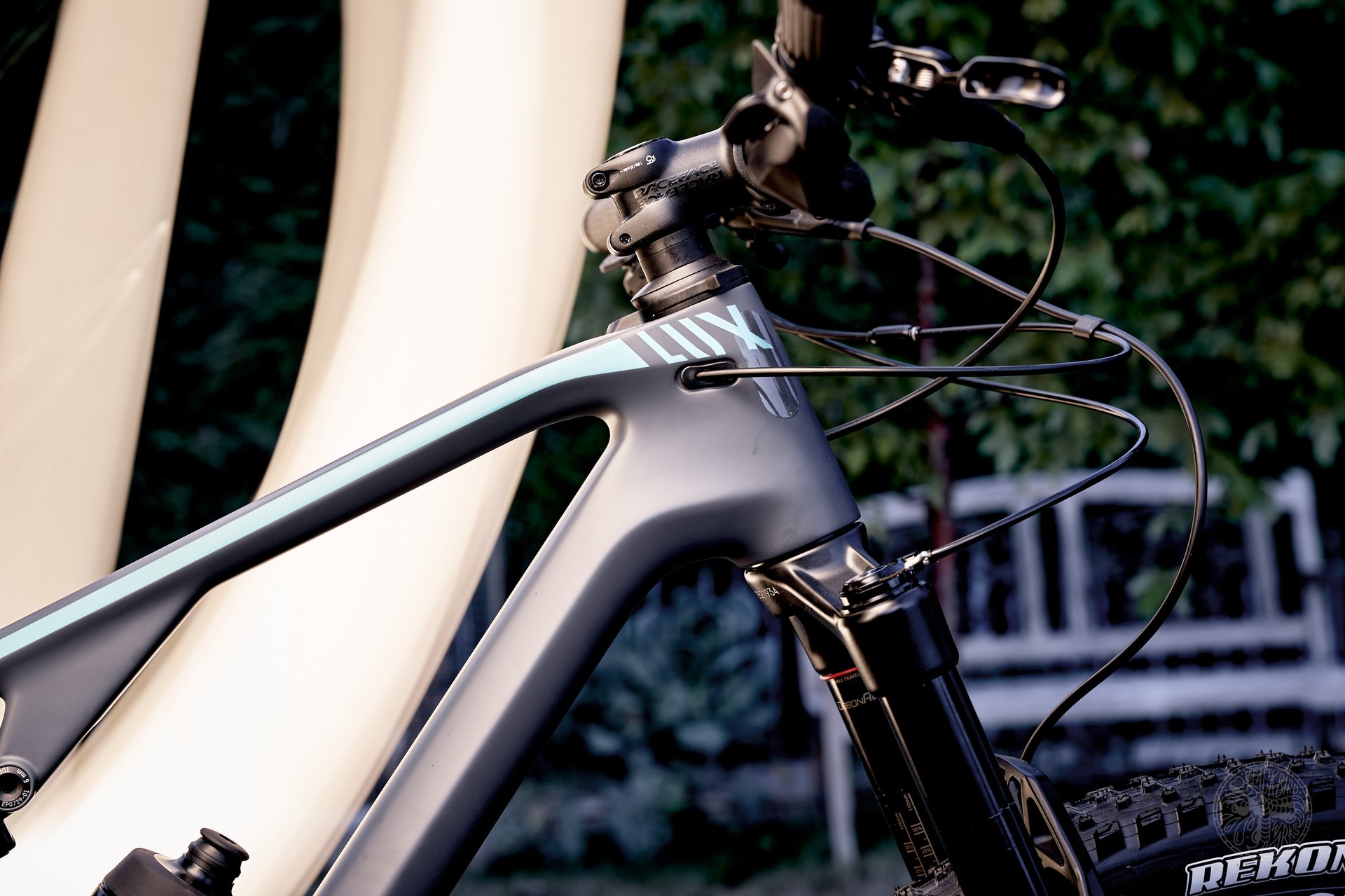
The heart of any bike is the frame. In this case, a firm 110mm platform with a neutral 67.5° head tube angle and power-friendly 74.5° seat tube angle.
The Lux Trail comes in four trims, headed by the Shimano XTR-equipped, 24-pound, CF 9 Emily Batty Edition. The base is the Shimano SLX-equipped, 27-pound CF 6 while the CF 7 is an XT build. Each of those bikes feature 120mm Fox 34 Step Cast forks, 100mm drop Fox Transfer SL posts, and a Schwalbe 2.4" Wicked Will in front and 2.35" Racing Ralph in the back.
This CF 8 is the one SRAM build in the lineup. It swaps out Fox suspension for RockShox SID Select+ fork and Deluxe shock, while a 125mm RockShox Reverb AXS replaces the 100mm Fox Transfer SL dropper, and of course the drivetrain switches from Shimano to SRAM. In this case, the SRAM setup is the relatively new GX AXS platform. The tires are switched over to Maxxis with a Rekon front and Rekon Race rear.
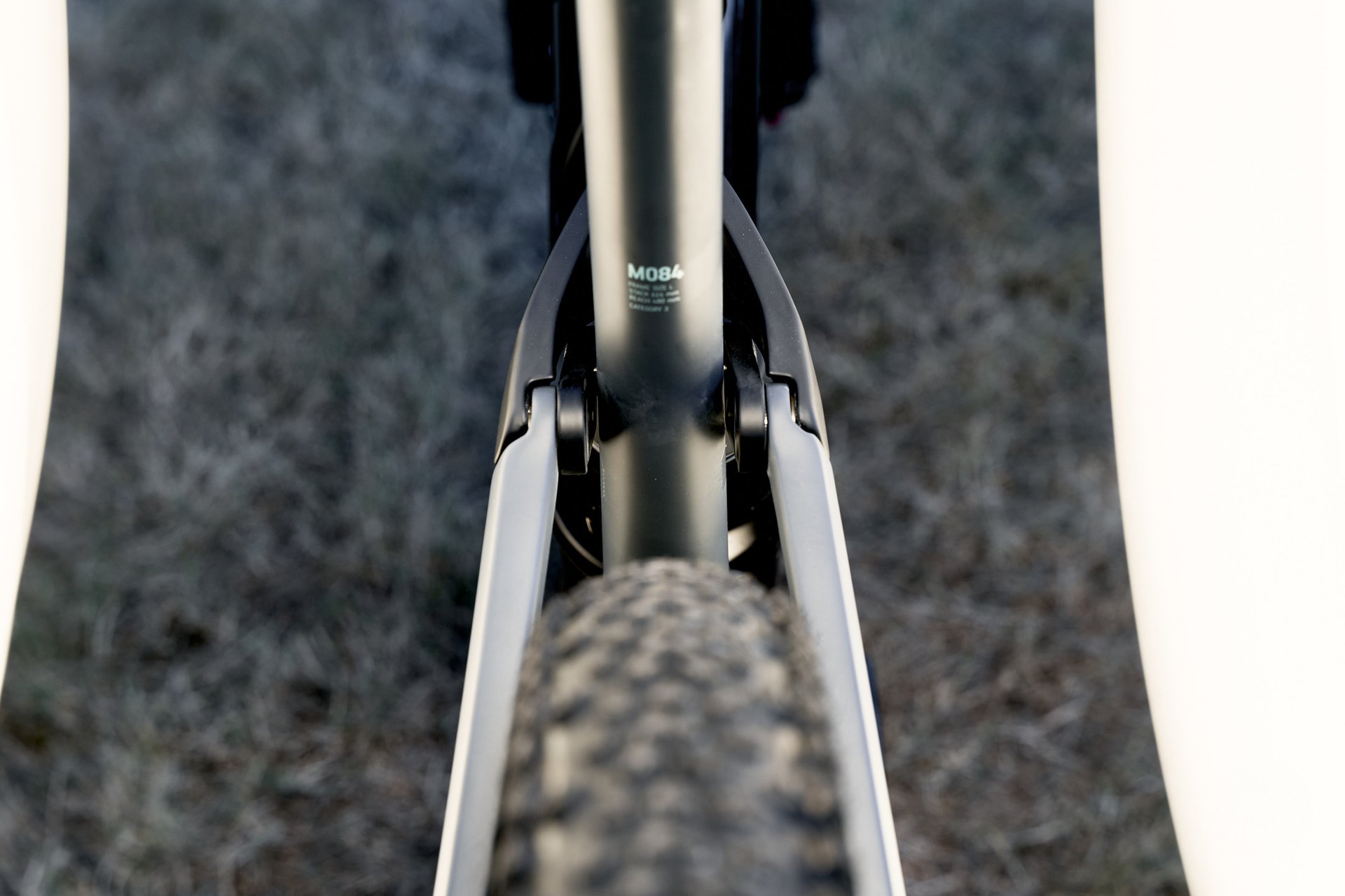
Plenty of space for a 2.4" Maxxis Rekon in the rear. The i30 rims are an interesting choice through the lineup given the stock tire size and intention of the bikes.
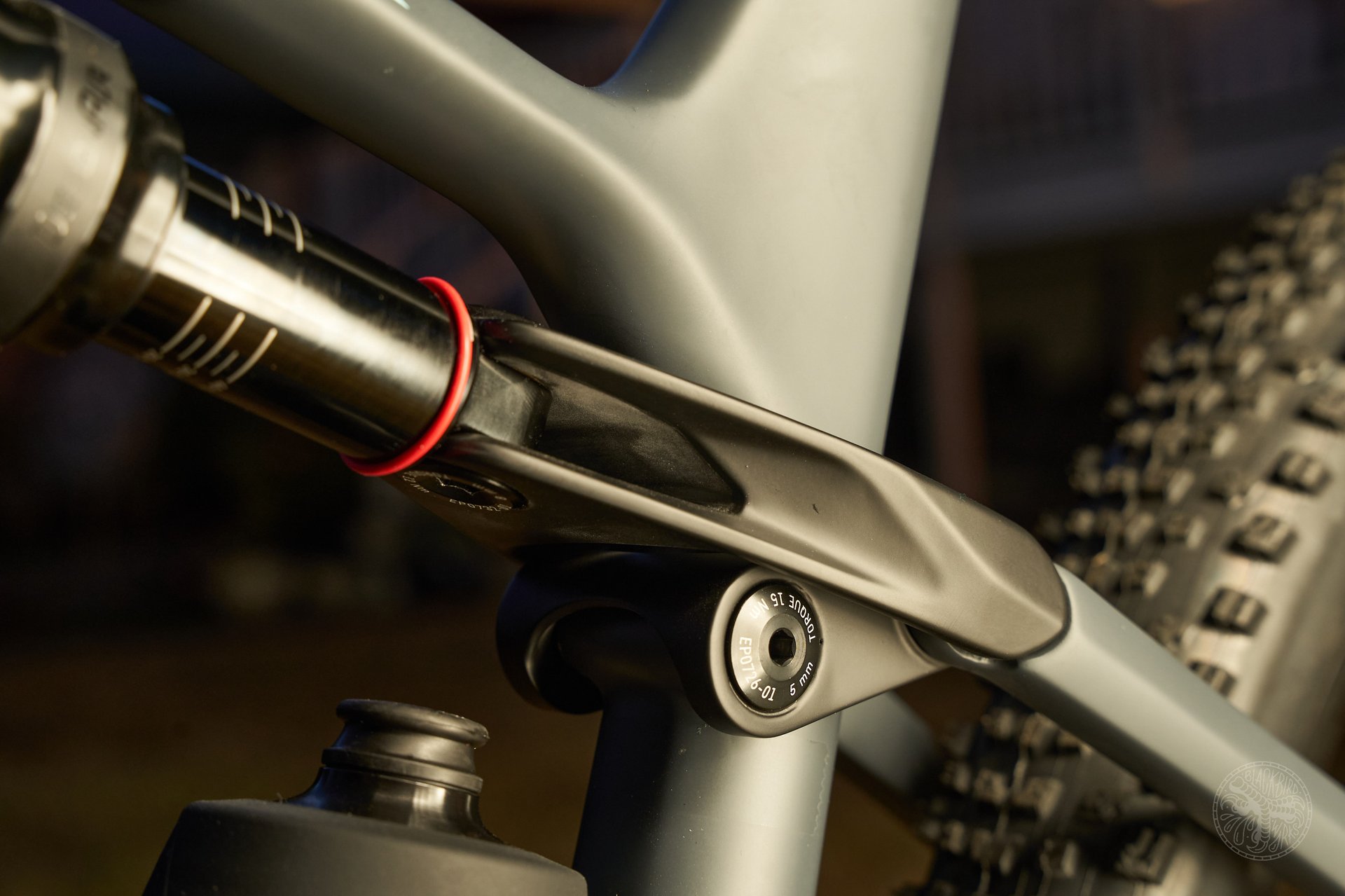
Almost everything about the Lux Trail frames is clean and minimalist. I couldn't figure out why it's so appealing until my friend Kim pointed out it looks like a hardtail. Ha.
It looks like a hardtail"
Geo Gymnastics
You can only tell so much about a bike from its geometry chart but my first impression is that the Lux Trail wears its numbers as accurately as any bike I've ridden. There's also an incredible similarity in handling, numbers, and fit between Kona's iconic Process 111 bikes and the Lux T. The Reach on a large Lux Trail is 20mm longer than the 2014 Process and the head tube angle (HTA) is half-a-degree slacker while the seat tube angle (STA) is half-a-degree steeper.
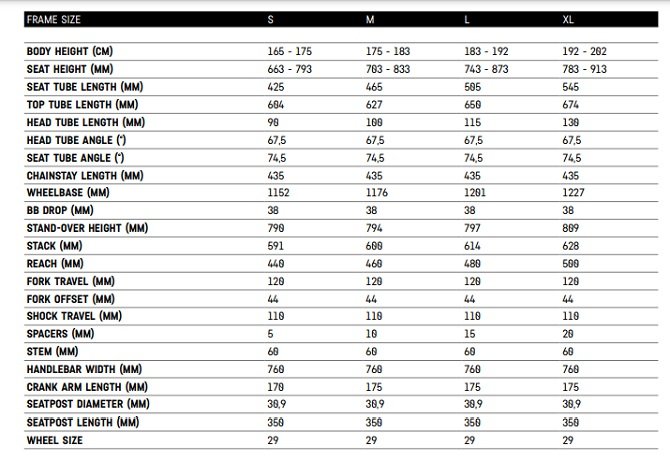
2022 Canyon Lux Trail Geo Chart.
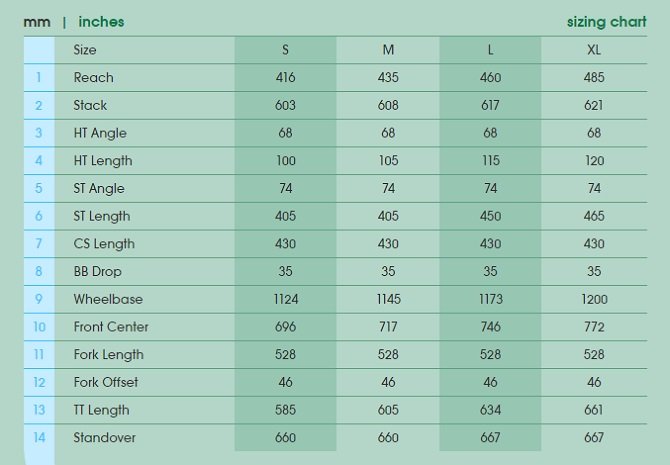
2014 Kona Process 111 Geo Chart.
The Canyon has significantly less standover, is designed to carry two more water bottles, has 5mm longer stays (435mm v. 430mm), but the stock travel is essentially identical with 120mm forks and 110mm rear travel. I think that Kona's first 1x specific trail bike is the most unique and interesting full suspension bike they've ever made - not to mention a great riding machine - so for me, this is all excellent.
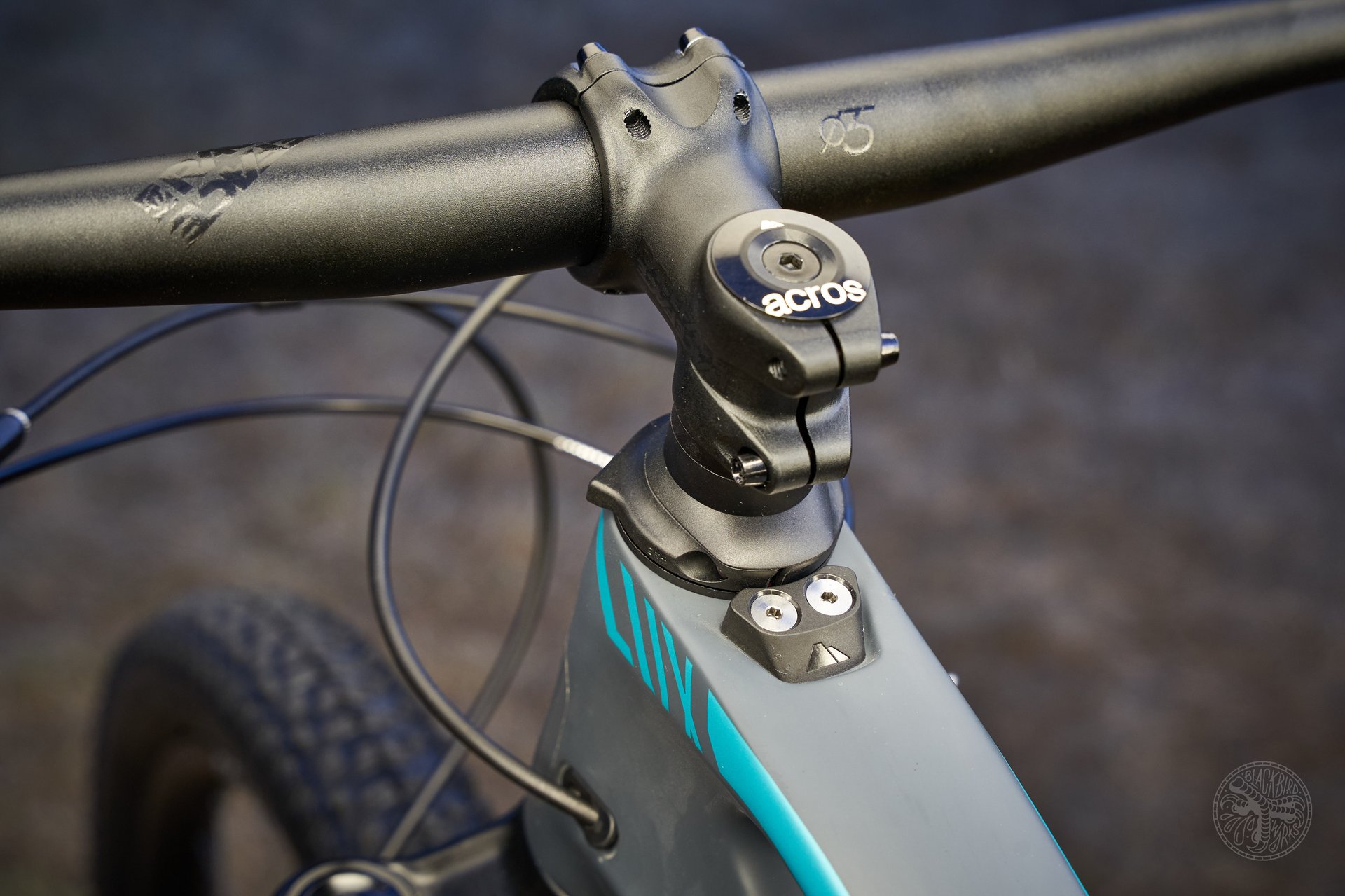
Canyon's steering limiter makes for tight clean cables and a full 180° of motion but does mean no bar spins. I would actually run this on my own bike.
I love messing around with a bike's geometry, and I know an ever-increasing number of fellow nerds who are trying +/- reach headsets and anglesets in their bikes but that's not an option with the Canyon due to the combination of a ZS44 (internal) upper headset cup and an IS52 (integrated lower bearing). It's hard not to assume the headset mix was intentionally chosen either to prevent that type of modification or to dissuade that, admittedly tiny, percentage of riders from buying the bike. Most the Process 111 bikes I've ridden were over-forked 20mm and if I have a chance to ride the Lux with a 140mm front end I will.
There may be two red flags on that geo chart for some North Shore riders, and riders of aggressive trails everywhere, the first being HTA. I think that every company would do well to aim for a 66° HTA on bikes of this travel and for this usage. I've already hit some aggressive descents on the Canyon and it's very rideable at 67.5°, I just think they could go a bit slacker without giving up anything in terms of climbing prowess or suspension performance over less steep terrain.
The other number that has folks shaking their heads is the STA. Personally, I love it for this application. The 74.5° seat tube angle is fantastic for creating power on most climbs and when the going gets truly steep the Lux Trail is efficient out of the saddle with the shocks wide open. It also has the option of the on-the-fly fork and shock lockout. The static position of a bike that rides this high in its travel on climbs also means that compared to many bikes with steeper STAs the actual rider position relative to the bottom bracket is going to be much more consistent on the Lux Trail.
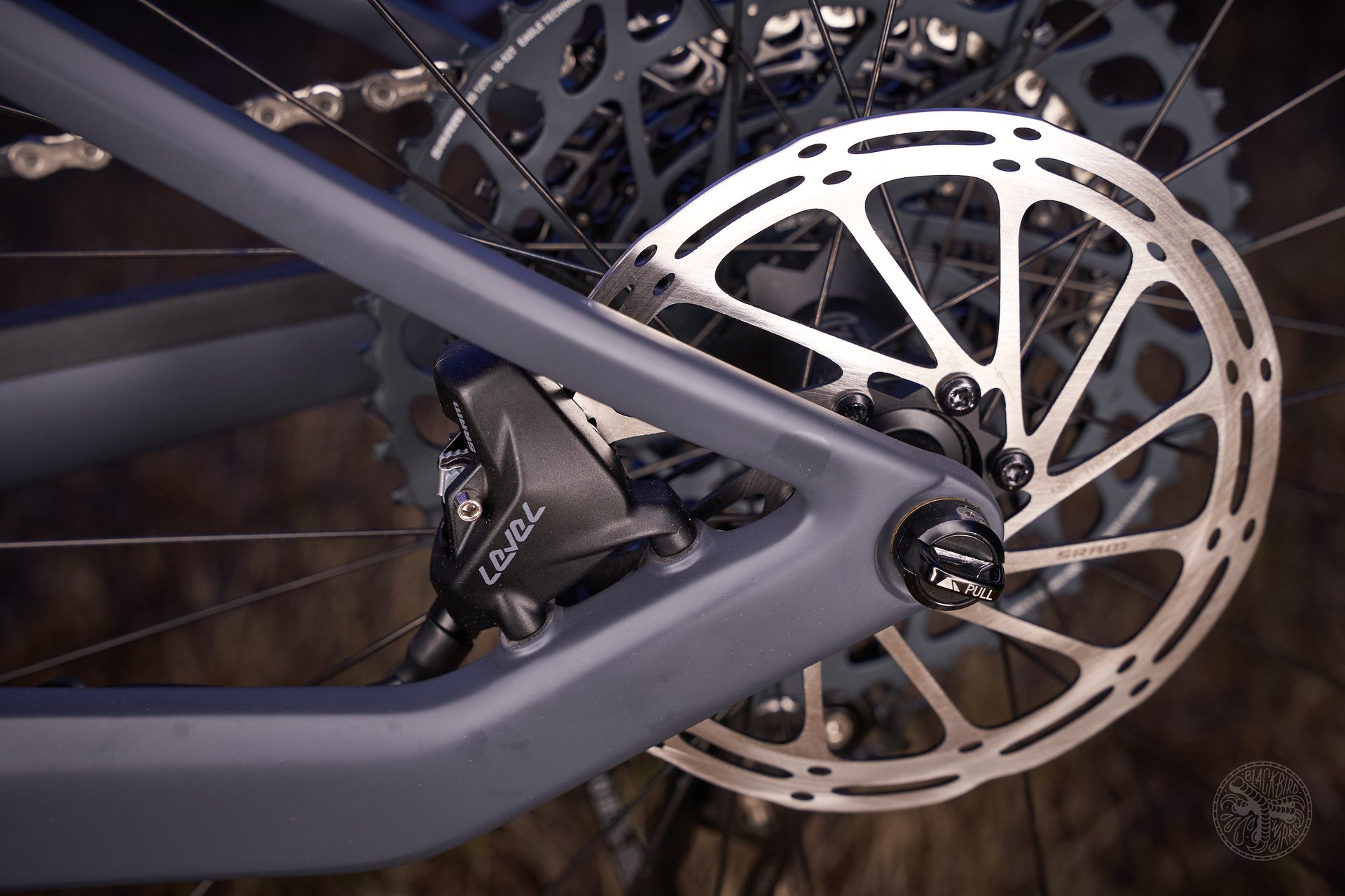
I shed a tear every time I see a flat mount road caliper on a mountain bike. But I grudgingly accept that the smaller mounting area makes it easier to design the flex stay.
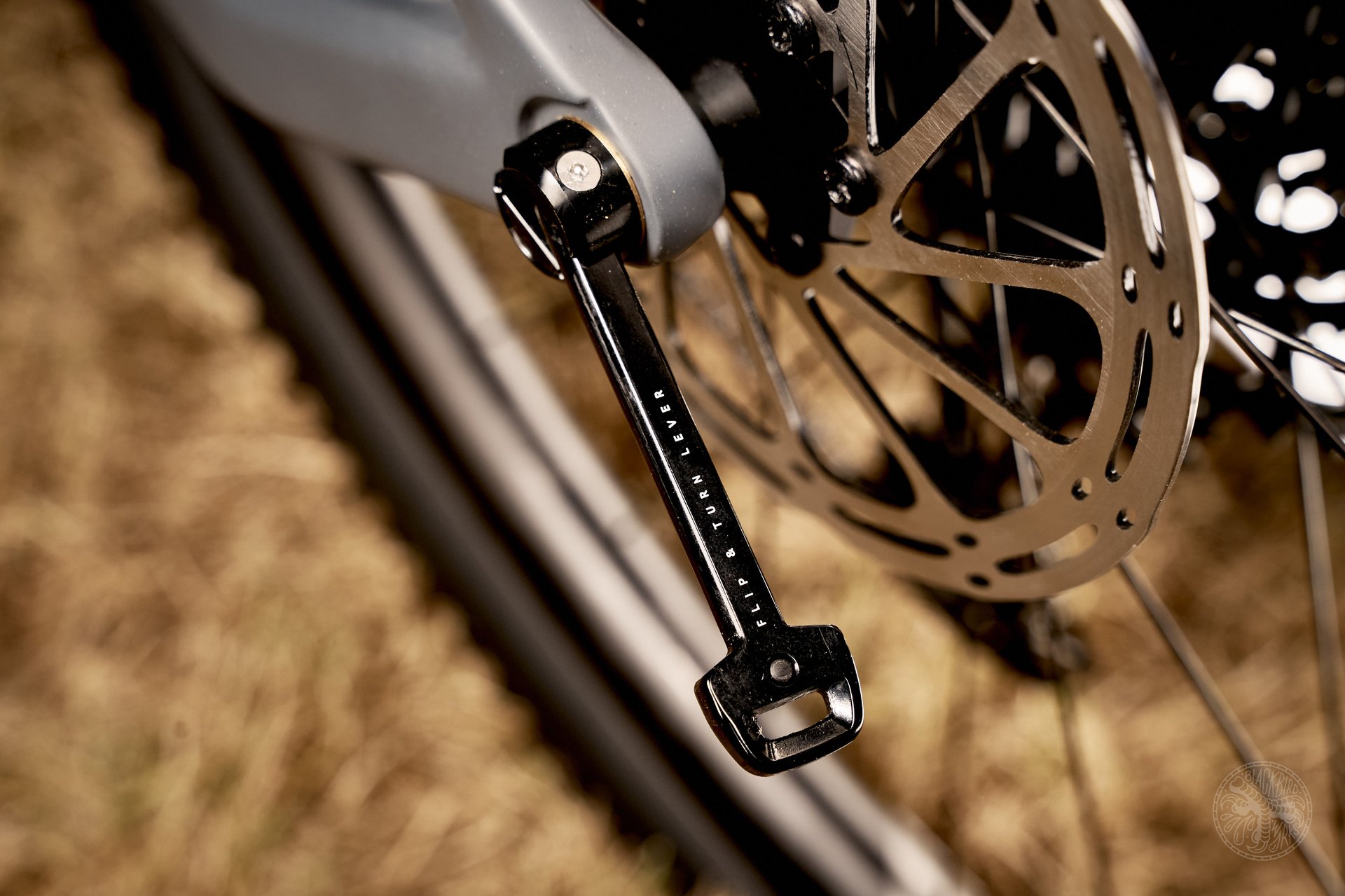
At first assessment the hidden lever for the 'Canyon Quixle' axle is nifty. It provides plenty of leverage when pulled out and is silent when installed. I think I'd just choose a simple hex-head axle though.
Sizing
The Lux Trail presented the hardest sizing decision I've had to make, including my custom single-speed frames. At 5'9", I'm nowhere near a large on Canyon's size chart. On the other hand, I haven't ridden a medium that felt big engouh since I start writing for NSMB. If I had a third hand, I'd also note that the reach and effective top tube on the large Lux Trail are pretty much spot on my Waltworks V2. With the option of adjusting Reach thrown out the window due to the turducken headset, it came down to a simple choice. Be the reviewer whinging about the too-small frame that a company recommended or be the reviewer eating humble pie after choosing a bike that was too big.
In the end, I think we were both absolutely right. If was going to ride the Lux Trail with the stock 60mm stem I would have been on a medium. With a 40mm stem and a 45mm ride SQLab 16° bar however, the bike feels absolutely perfect. Canyon manages to put enough money into the bar and stem that they're rideable while not wasting a bunch of dollars on high-end cockpit parts that many riders will swap out.
With the large frame the 505mm seat tube length doesn't leave me a lot of room for a dropper post. I have about a centimeter of adjustment to spare running a 125mm AXS Reverb. This is something to consider if you have a longer torso-to-leg proportion and are deciding between sizes.
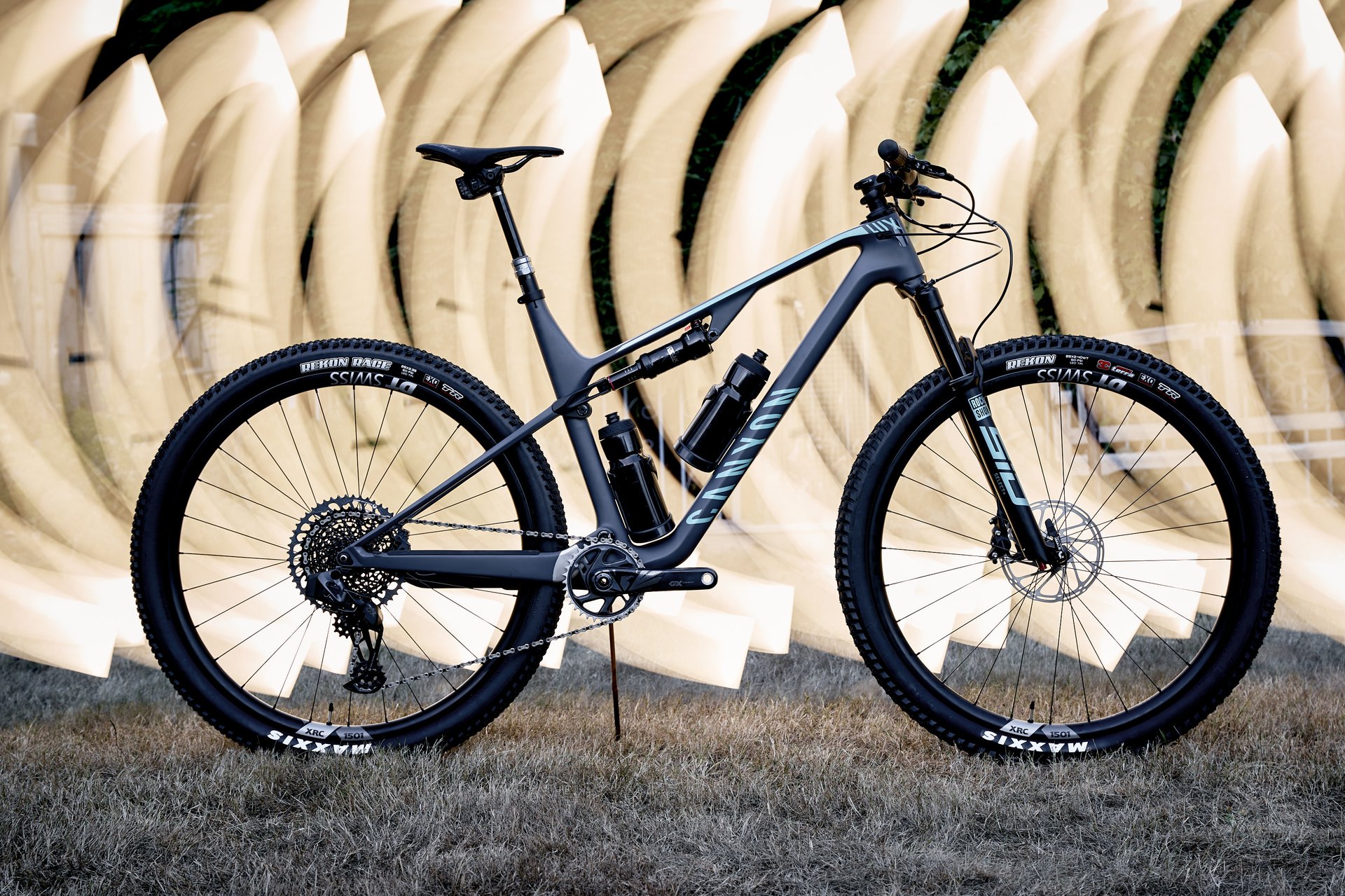
The alternate title shot. I love the 'hardtail aesthetic' of the Lux Trail. I think the size large could have a slightly shorter seat mast.
AXS
AXS wireless shifting works great. And frankly, if you don't have a scale I think the AXS GX stuff works just as great as the higher-end versions. I'll give a solid tip of the helmet visor to the weight and longevity of the XO1/XX1 cassettes but that's a large part of the price difference, isn't it?
I find the beeping the derailleur makes every shift annoying for the first five minutes of every ride but I don't notice it again until the next time. The shifter ergonomics always take a bit of brain retraining but again, after five minutes it's smooth sailing. Nothing has changed from my previous impressions of AXS drivetrains though. They work great.
Anyone who says AXS shifting is a ‘must have’ or ‘experience changing’ is full of of sh*t. On the other hand, if you don’t think that wireless shifting is cool, or at least ‘I’d never own it but it’s cool’ you may want to check your pulse. I ran it through my coolness testing protocol - also known as my seven year old - and AXS passes muster. Garbage trucks? Cool. Seabus? Cool! Skytrain? Cool! AXS? Très Cool!
Personally, I’d more than happily trade the GX AXS groupset straight across for a full X01 cable-shifted setup. Without a second thought.
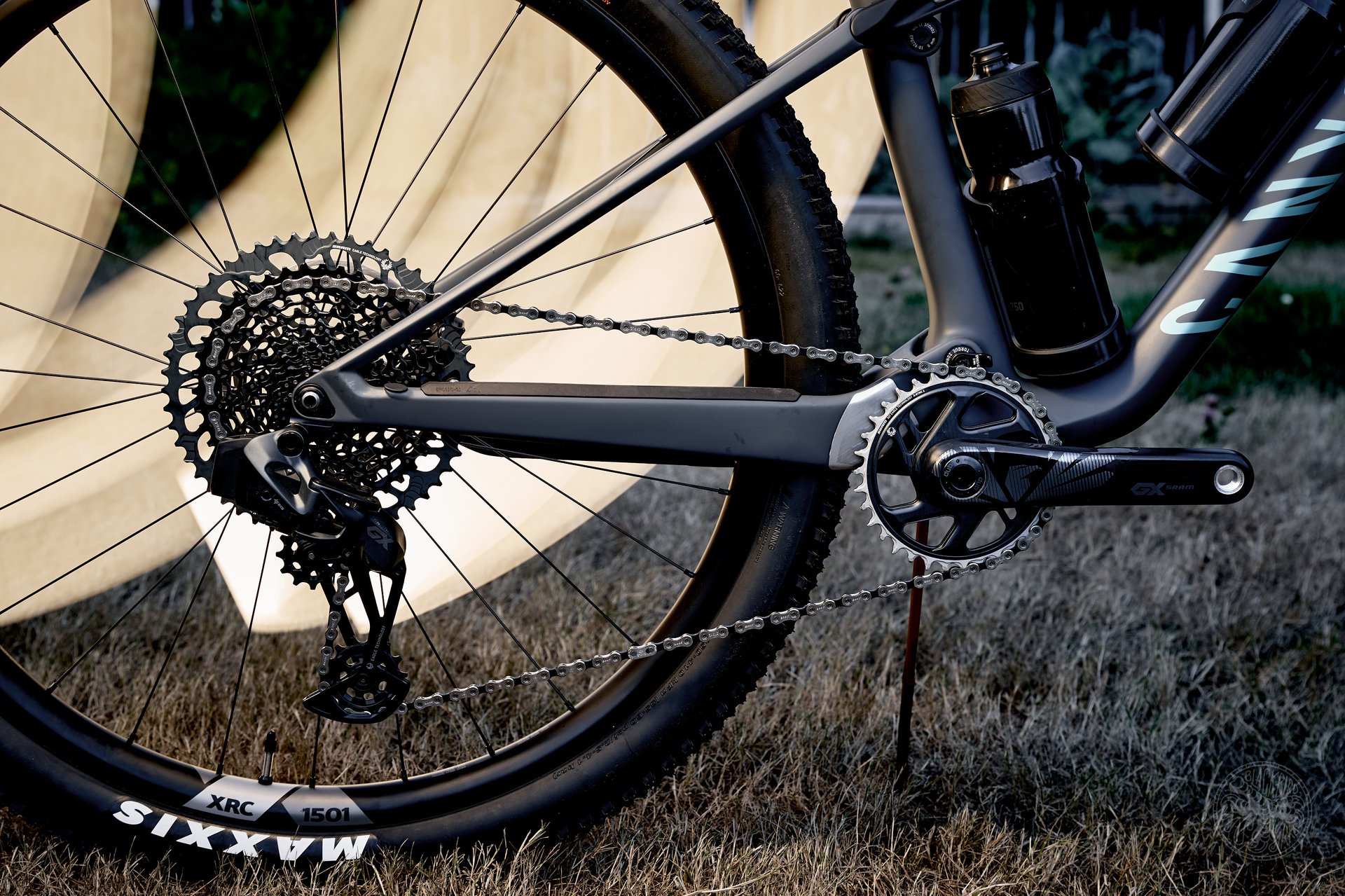
The GX AXS drivetrain is excellent though the big jump up to the 52t bailout gear sucks just as much with the wireless group as it does with a cable setup.
The AXS dropper post on the other hand is delicious. I'm a bit ashamed at how badly riding one makes me pine for my own 170mm travel version for my single-speed. No cable means easy removal after a rainy ride to let my frame breathe, the action is so, so light, and the absence of a dropper cable makes everything clean. I could never justify the price over my favourite cable-actuated posts but that doesn't dull my lust.
The CF8 sports carbon SRAM Eagle GX cranks and I can think of a few places I would have invested the price jump over aluminum, but then a lot of potential customers might be more surprised by the lack of a carbon bar rather than the addition of carbon cranks.
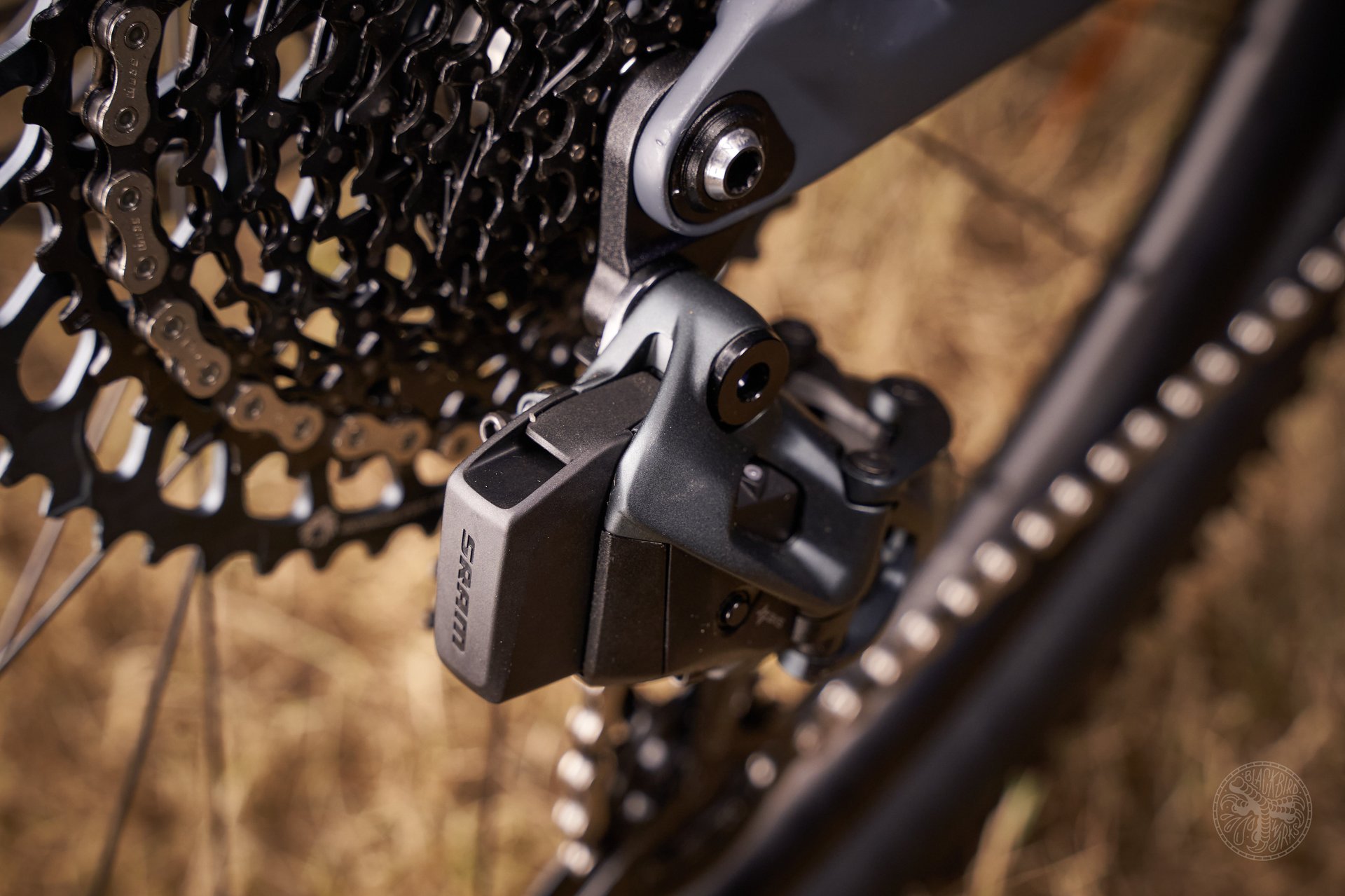
I didn't charge the battery before my first toodle around and of course it died on me. No big deal. I just swapped over the one from the AXS dropper.
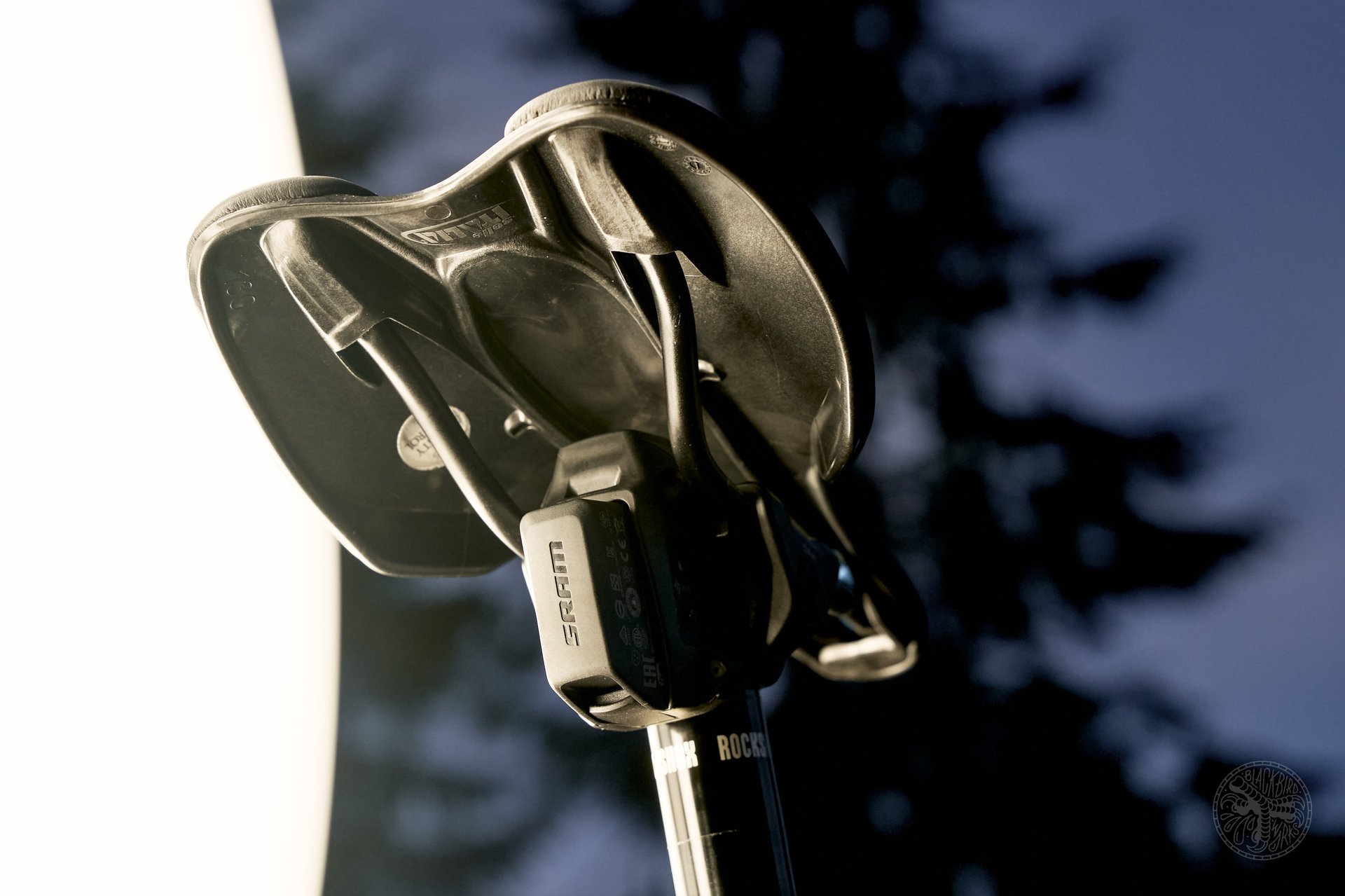
How do riders who can't remember to lube their chains (we hear you) keep their drivetrains and droppers charged?
Wheels-First Philosophy
I love the idea of spending extra money on the parts of a bike that most riders won't likely be replacing hastily. It's min-maxing at any budget. While I'm a bit surprised that Canyon chose to go with i30 rims for the lineup, given the tire sizes they spec, it's pretty impressive to see DT 240 hubs and carbon rims on the Lux Trail.
DT Swiss is obsessed with direct-pull spokes, where I'd prefer J-bend, but everything else checks out. They use 6-bolt hubs instead of Centerlock with a 6-bolt adapter and this is a spec choice that I love. The XRC 1501 wheels use 3x cross lacing, the spokes are DT Competitions, and the Squorx aluminum nipples work great. The wheels have a 110kg | 242lb weight limit which corresponds to the weight limit for a rider and gear that Canyon publishes for the bike. I will find out if that's a weight limit for the frame or if the weight limit for the wheels sets the limit for the bike.
Canyon lists the max recommended tire size for the Lux Trail as 2.4" and in my experience 2.3" and 2.4" tires generally work great on rims with a smaller internal diameter which would also drop a few grams and possibly protect the rim better. Interestingly, the 100mm travel Lux CF race bikes are also running i30 rims, so it may just be that I'm ahead of, or behind, the curve in thinking i25 rims are great for <2.4" tires.
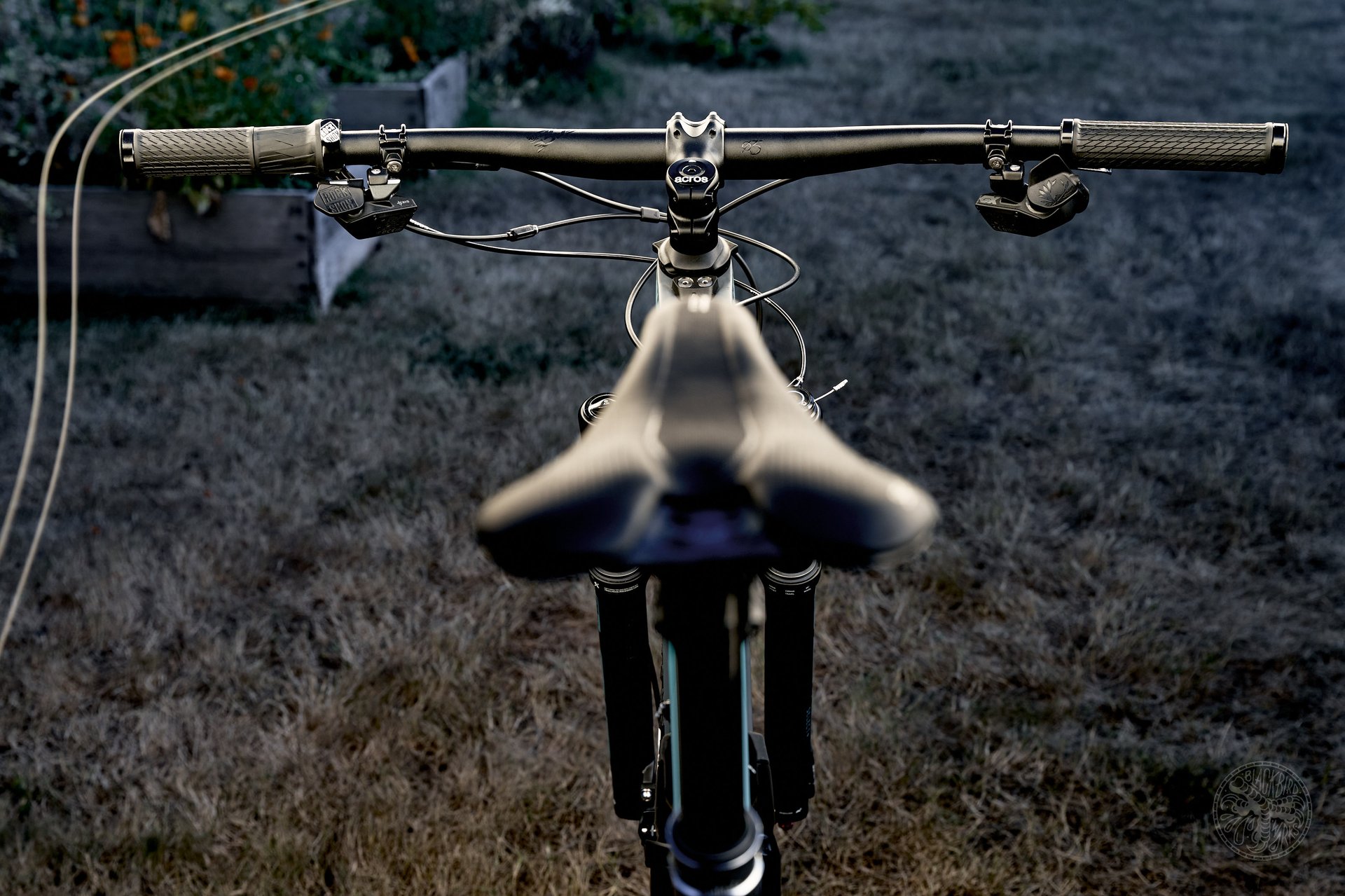
The Race Face Ride 35 bar and stem are very basic kit to show up on a bike of this price and purpose but I think that's great. They're totally rideable and the choice doesn't waste a bunch of money on Gucci cockpit parts I'll likely be changing out.
This is the first bike I've ridden with DT Swiss' new RATCHET EXP freehub system, in this case, mated to some 240 hubs, and my first impression versus other DT Swiss hubs is that it is loud, loud, loud. I run my Industry Nine Hydra's with Dumonde Tech Freehub Grease to quiet them but even with the Hydras run dry, the RACHET EXP is screaming ahead by many decibels. It's actually a bit antagonizing, which is surprising given they have a rather broad 10° between engagements. It's early days and the system may need to break in a bit, and I may need to read up on warranty-approved lubrication options.
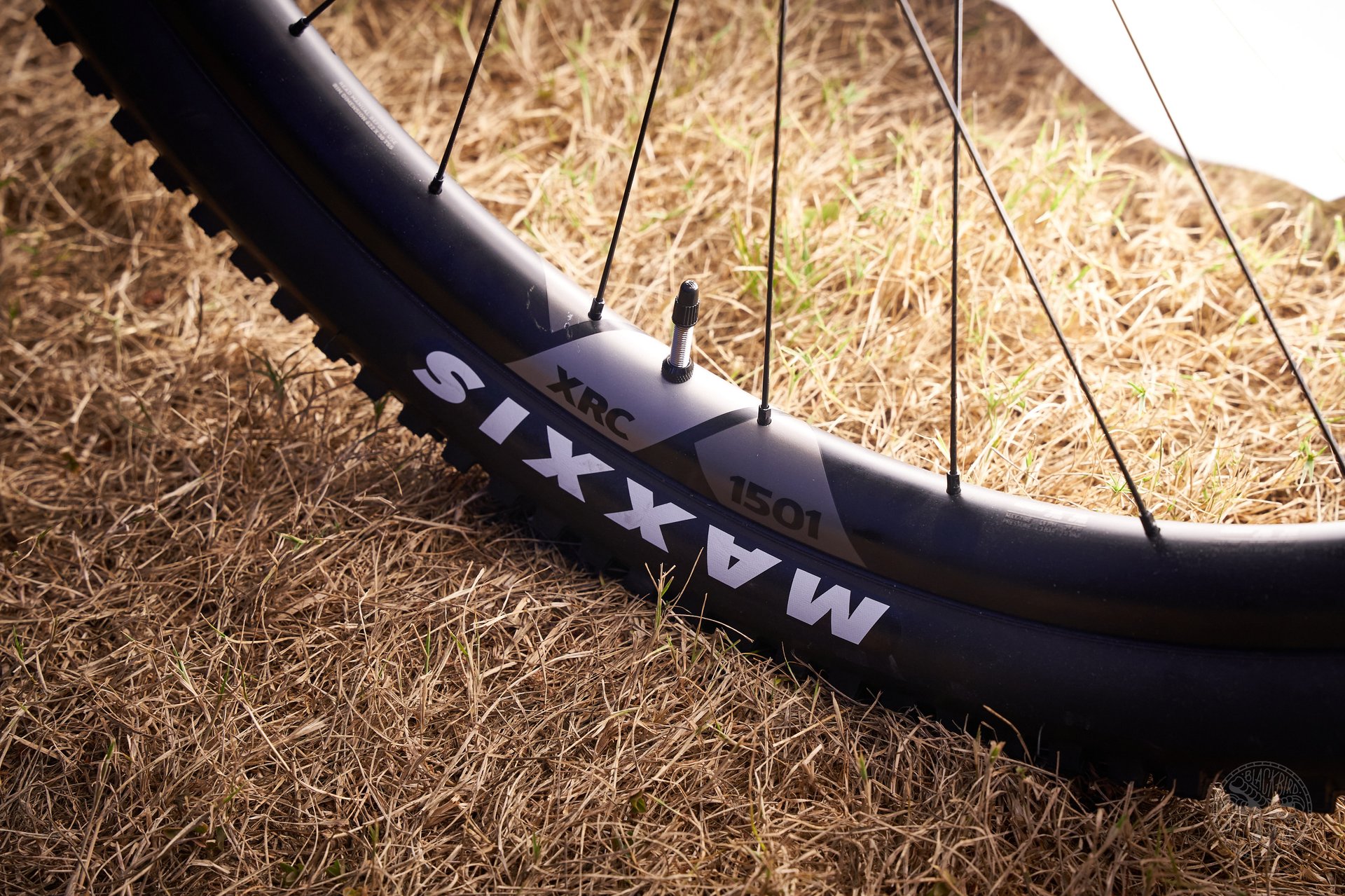
DT Swiss' XRC1501 uses their 240 hubs, Competition butted spokes laced 3-cross, aluminum Squorx nipples, and i30 carbon rims.
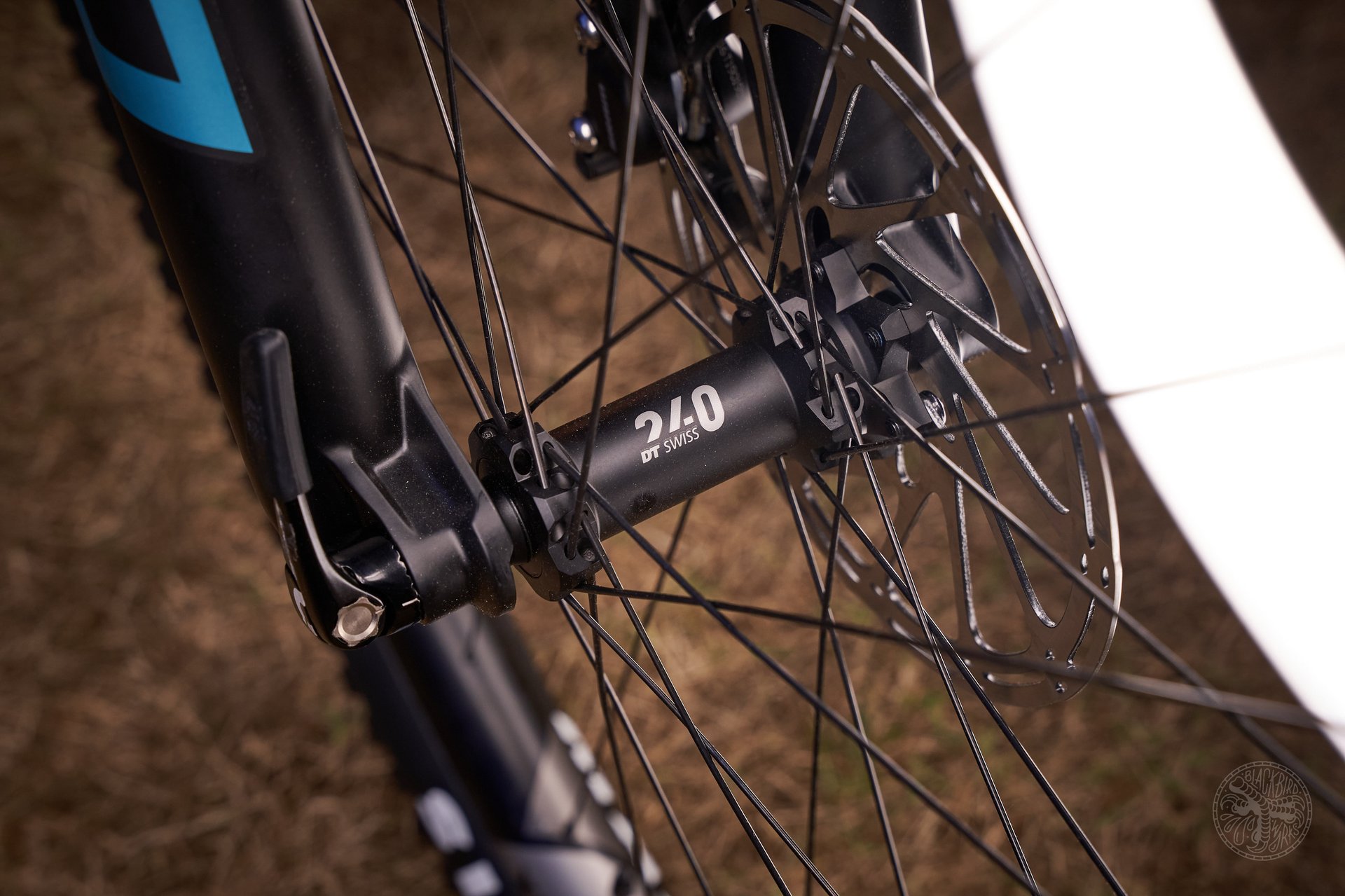
I love that these 240 hubs are six-bolt instead of Centerlock. This is my first experience with the LOUD NEW RATCHET EXP freehub system.
Spec Crimes
"Sweet, I didn't know that NSMB tested gravel rigs" -anonymous
Sometimes there are really bad spec choices. These are the decisions a product manager has made that are going to cost customers money, ruin the reception of the bicycle, they deserve to be called out hard, and often, for making them. Keep in mind, this is not the Lux CF World Cup XC race bike, but rather a machine that Canyon claims is a bike with "a calm feel at the controls when you are barreling down steep trails."
That's bullshit as the bike currently sits, but it's probably a surprise that Canyon's crime numero uno is not actually their choice of horrific SRAM for-Level-ground-only hydraulic flat-bar road brakes, but rather the guillotine that's branded as a Selle Italia SLR saddle. I'm a long-time fan of the SLR and have owned a few of them for both road and mountain bike riding, but this specific model is absolutely not a mountain bike saddle with the wicked plastic blade at the back. In general, it's a weird choice because there are at least as many riders who don't get along with them as do. It's very hard to imagine anyone riding legitimate offroad trails anywhere choosing to ride this saddle.
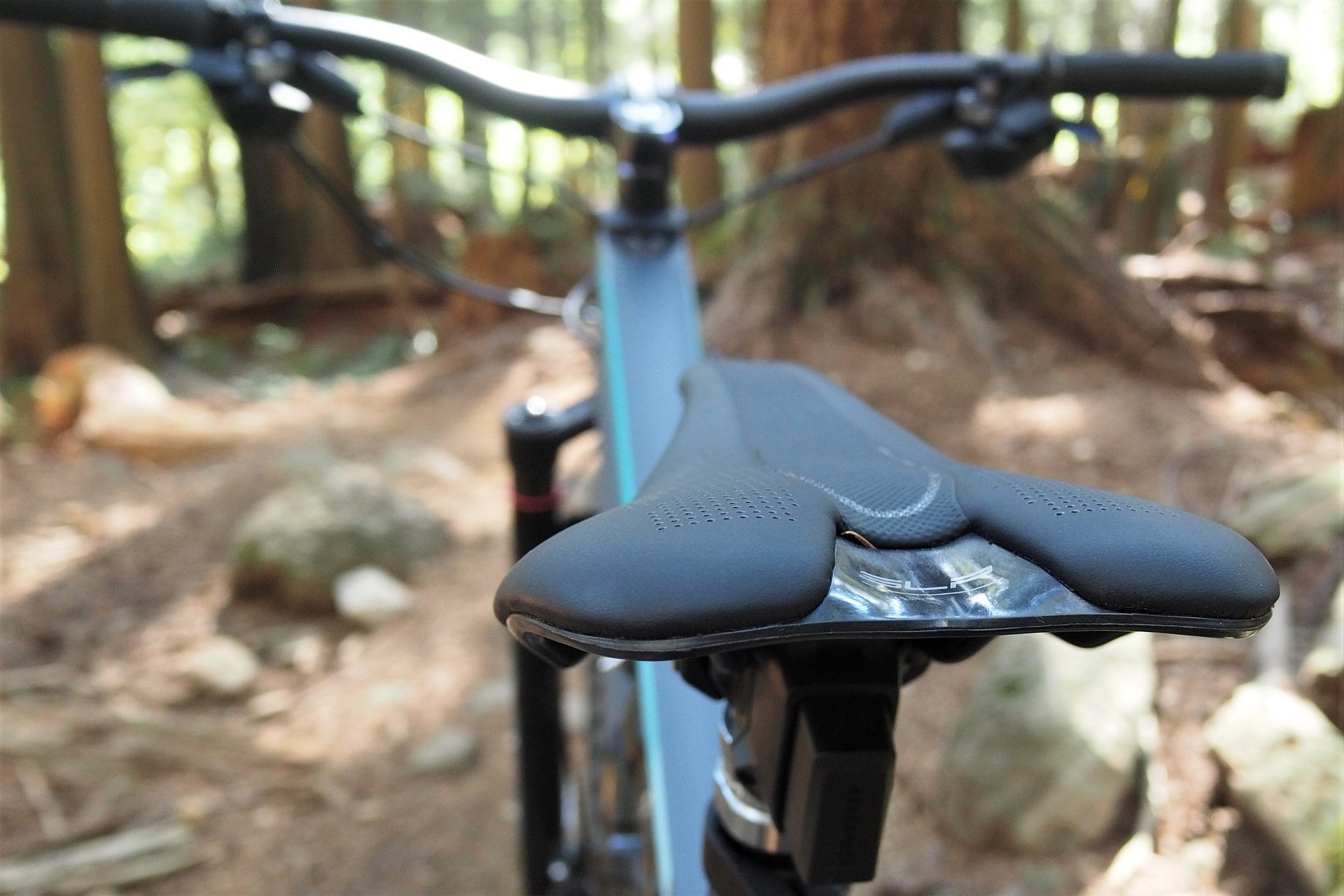
Hitting yourself on the blade on the back of this SLR feels exactly like you'd think it would. I left it on for one ride, and that was one ride too many. (Photo: AM)
If this Lux was a full-blown XC-Race superbike with XO1, and German-carbon everything, maybe some TUNE hubs, a Syntace cockpit, and some deadly race rubber front and rear then I could excuse the choice to spec SRAM's two-piston Level brakes. They're lighter than SRAM's other options and when you're running micro-knobbies there's only so much braking traction to be delivered. But a GX spec level of bike, even with cross country intentions, is not a dedicated race machine, and the Level brakes are absolute theft. I cannot imagine a rider buying the Lux Trail for its stated purpose and being happy with these. At 190lbs I don't even like riding it down semi-steep gravel trails in North Vancouver. Trying to maintain control, never mind stopping on steep terrain, is absolutely terrifying.
The flat-mount brake mount on the Lux Trail doesn't limit Canyon to running flat-bar road brakes, there's an adapter for that. And if it simply has to be two-piston flat-mount brakes, do the German thing and spec some Maguras. Actually, some Magura MT Trail Sport brakes would be a great choice for this bike. I couldn't force myself to do another 'real' ride on the Level front brake so if you're wondering why there are only 1/2 cockpit shots from now on it's to hide the fact that I'm running mix-matched brakes so I can use systems I already own.
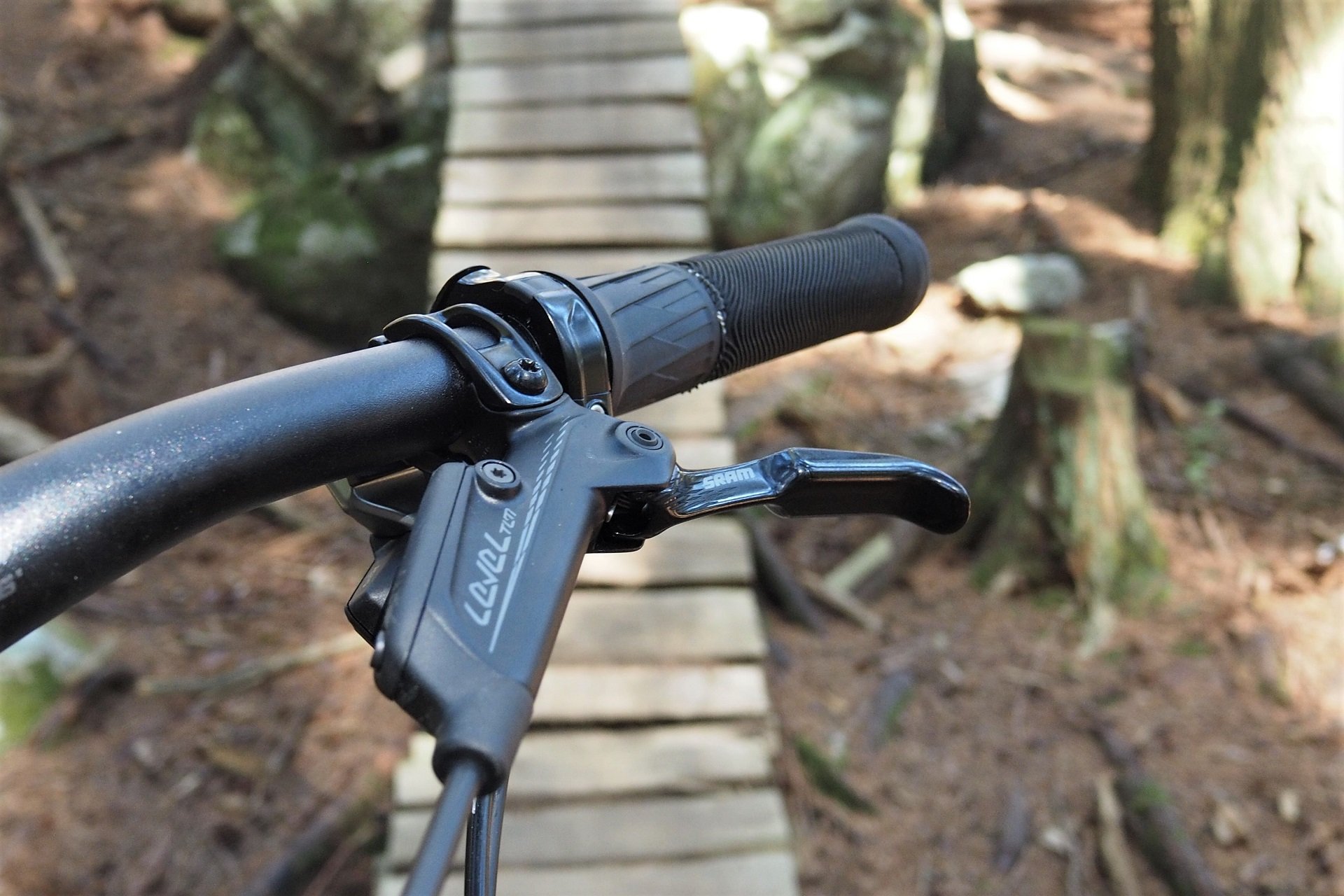
SRAM Level brakes are exactly like Shimano M975 XTR disks. They feel awesome when you pull on the levers in the shop and they deliver panic-inducing v-brake level stopping on the trail. (Photo: AM)
I also am going to file a complaint about the stock 34t ring. This isn't necessarily Canyon's fault but rather my main beef with the current version of SRAM Eagle. Frankly, the new 52t cassette cogs make product managers lazy. They see a 10t high gear and a 52t low gear and they choose a ring size that they assume makes the most effective use of that range for the most locations the bike will be sold at. Unfortunately, while probably suitable for a Lux XC race bike, the 34t ring that comes with the Lux Trail means the average rider anywhere with hills is going to spend a lot of time in that 52t cog. That cog is aluminum instead of steel and also has such an awful chainline that I can feel the extra drivetrain wearing as I pedal. With the 34t, I'm either buying a new ring on day one or wearing out a chain and a cassette way faster than I should.
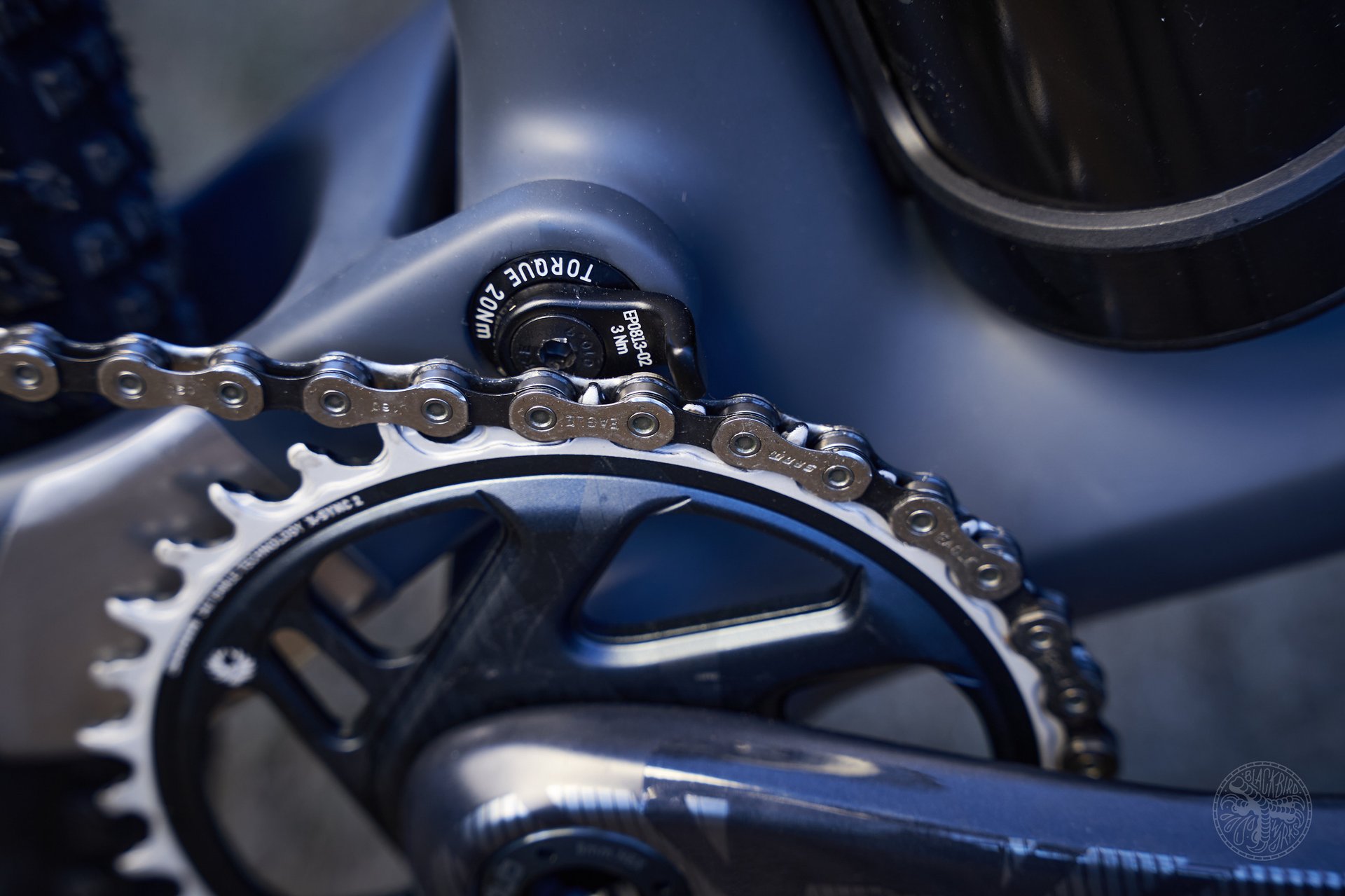
The 34t ring on the Lux Trail is going to have most riders who climb hills either riding their 52t cog all the time, and replacing a cassette prematurely, or buying a smaller chainring.
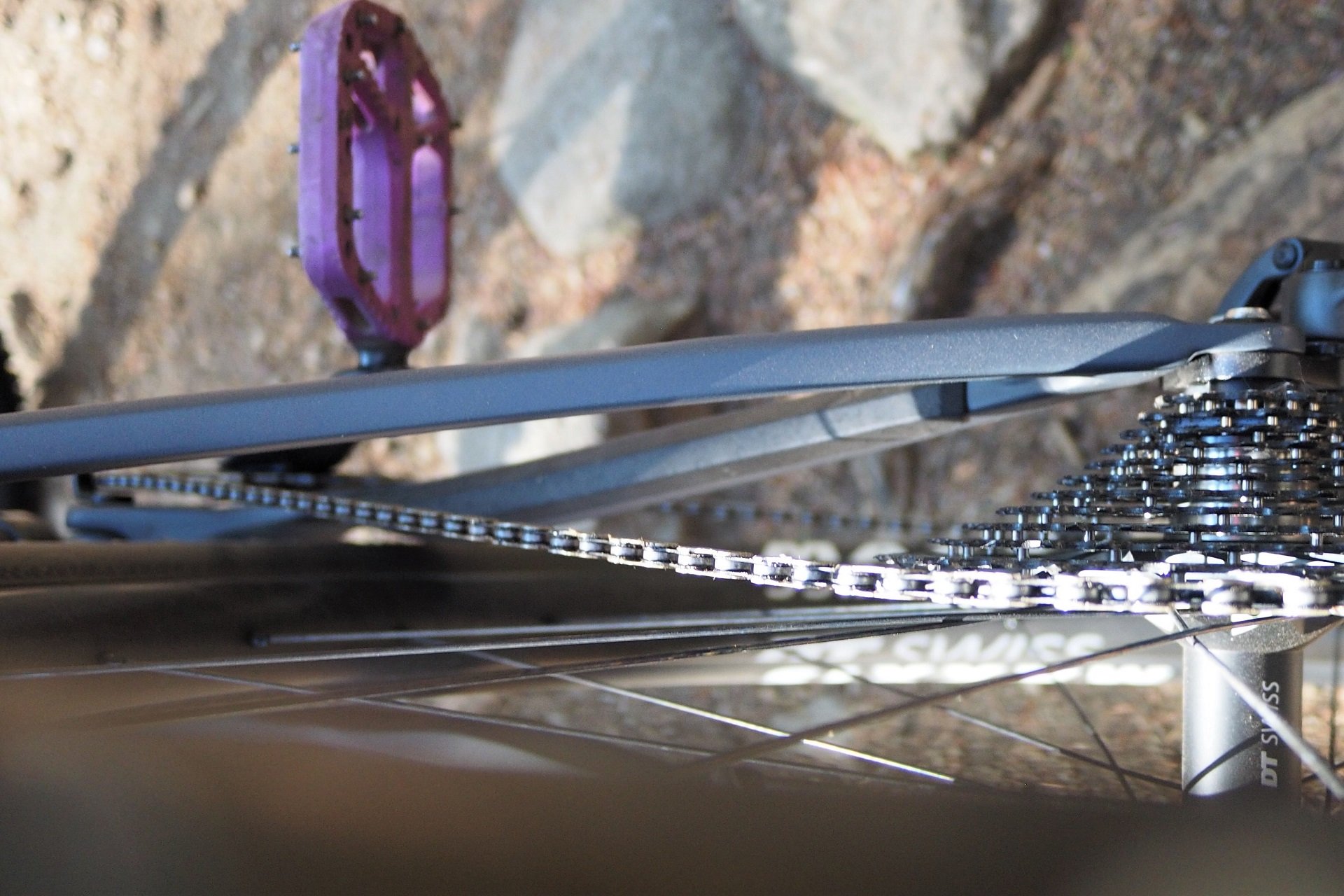
The chainline in the 52t is horrendous. All bikes should be geared so this is an end-of-an-epic bailout option only. With a 30t ring, I'm climbing in multiple cogs with better chainlines. (Photo: AM)
Limited Shore-ification
My philosophy for this Canyon is to do the bare minimum to make it fun for Tech-C riding while leaving the bike as stock as possible and keeping the weight light while preserving the trail bike intentions.
For the saddle, I'll be playing with running a couple of different favourites, the BikeYoke Sagma and SQLab 60X, for the chainring I'm planning to pick up a 30t oval, and I have a four-piston Formula Cura 4 brake that has a similar enough lever blade ergonomic to the Levels that I think my brain will be able to overcome the mix of manufacturers.
I've also made some cockpit changes, swapped some rubber around, and installed a pair of my go-to push-on grips so the bike feels like it's mine.
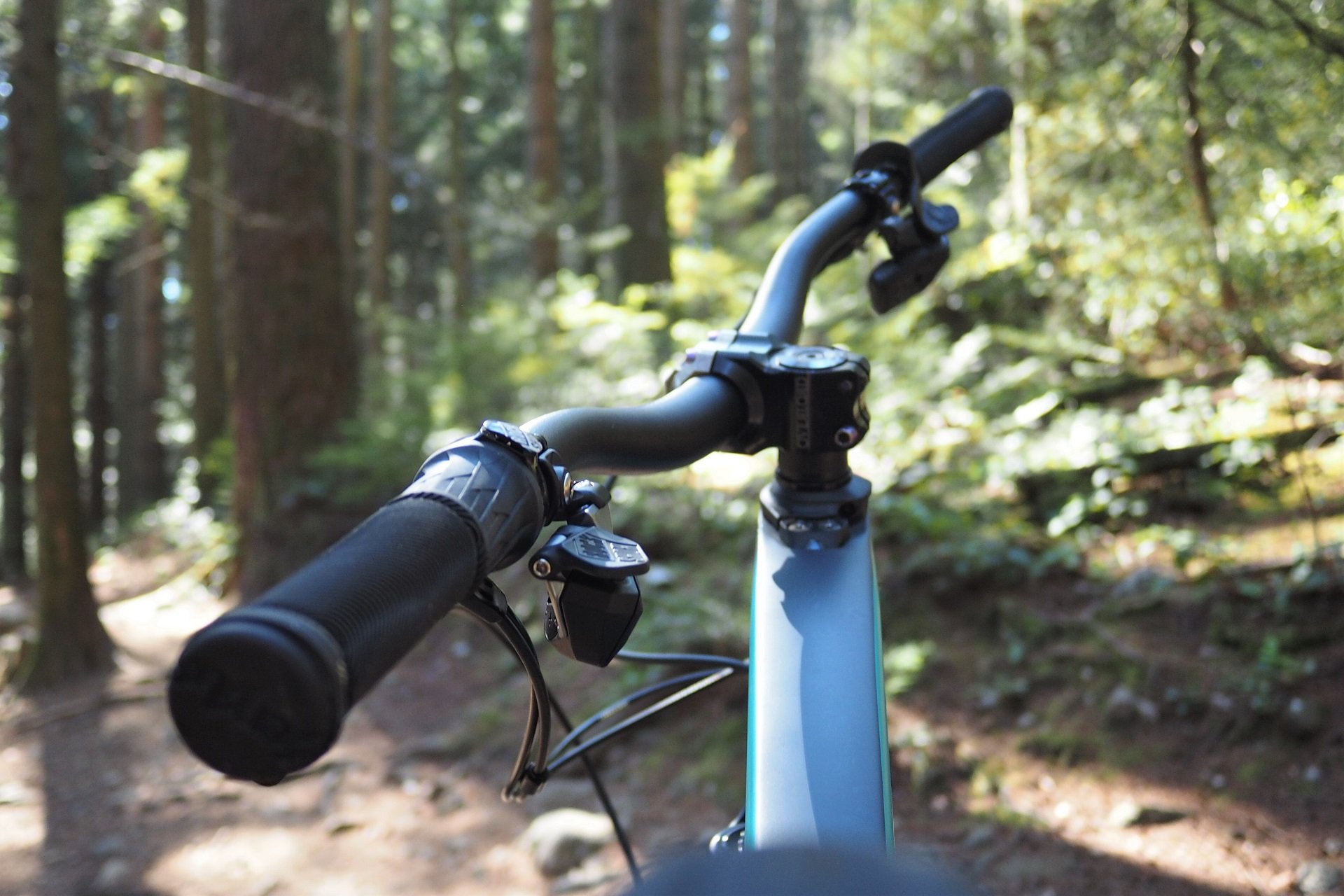
A 40mm long NSB Overlord stem and 45mm rise SQLab 30X bar change my position on the Lux Trail substantially. I swapped the lock-ons for a pair of Swayze grips. (Photo: AM)
The first bike changes I made were actually in the rubber department. I moved the stock Rekon front tire to the back, put the Rekon Race tire aside in case I want to go extra spicy in the future, and I put my own 2.4" Maxxis DHRII EXO+ MaxxTerra tire in the front. The DHRII has never been my favourite front tire but shortages have me currently running the MaxxTerra version on the front of both my bikes and I appreciate the consistent braking, for reasonable rolling resistance, in our current conditions.
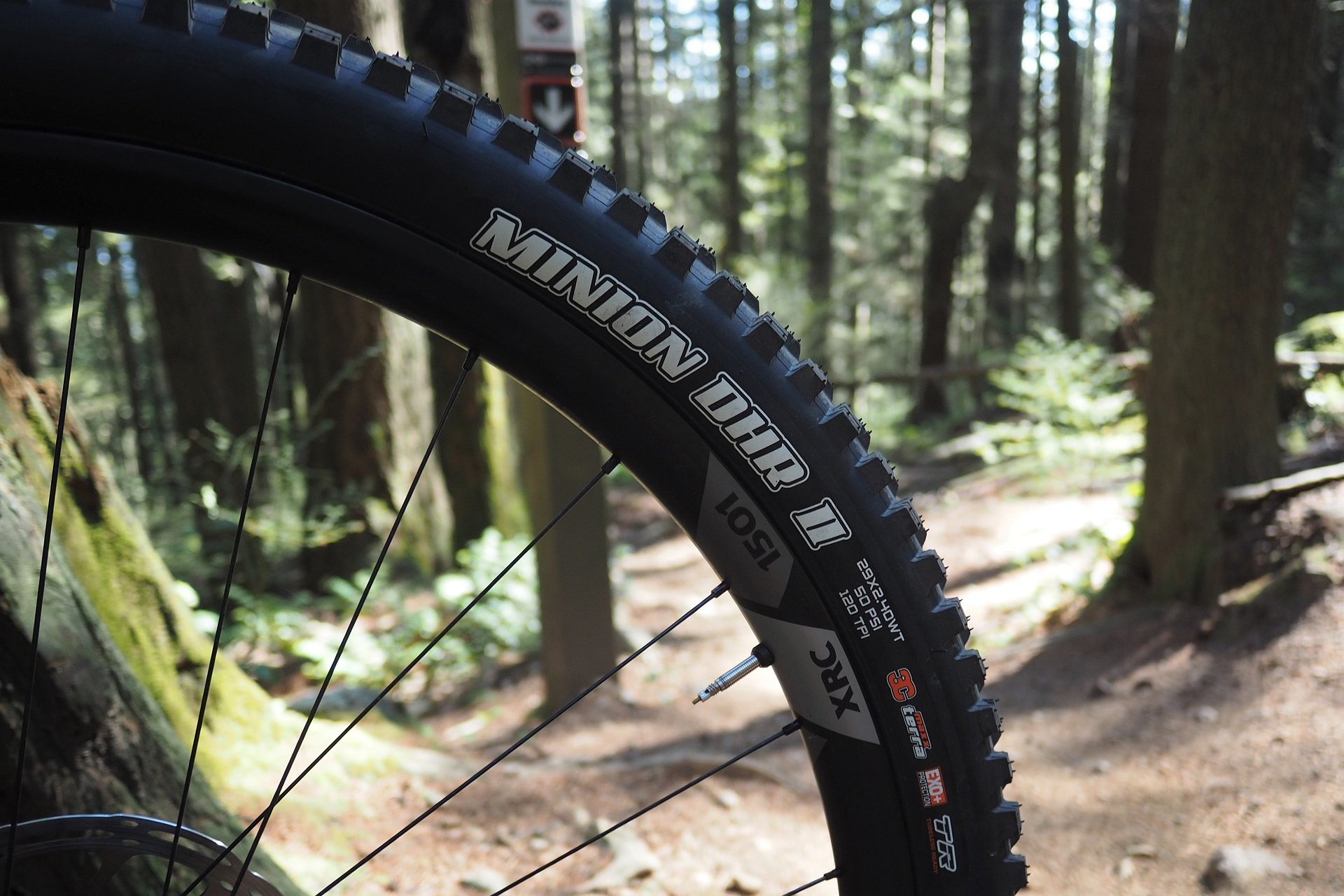
Fresh rubber on the front - no inserts! I moved the Rekon from front to back and installed this MaxxTerra EXO+ DHR2 in front. (Photo AM)
I'm surprisingly comfortable on the 125mm dropper post on every trail I've taken the Lux Trail down. This is fortunate since I'd need to drop to a medium frame to run a longer dropper than stock. As with the headtube angle, or my proposed 66° HTA update, I think the dropper post is a good limiter for me in terms of keeping to riding terrain where the Lux Trail will be fun. I'm planning to stick to the traverses and the steeps that I'm used to.
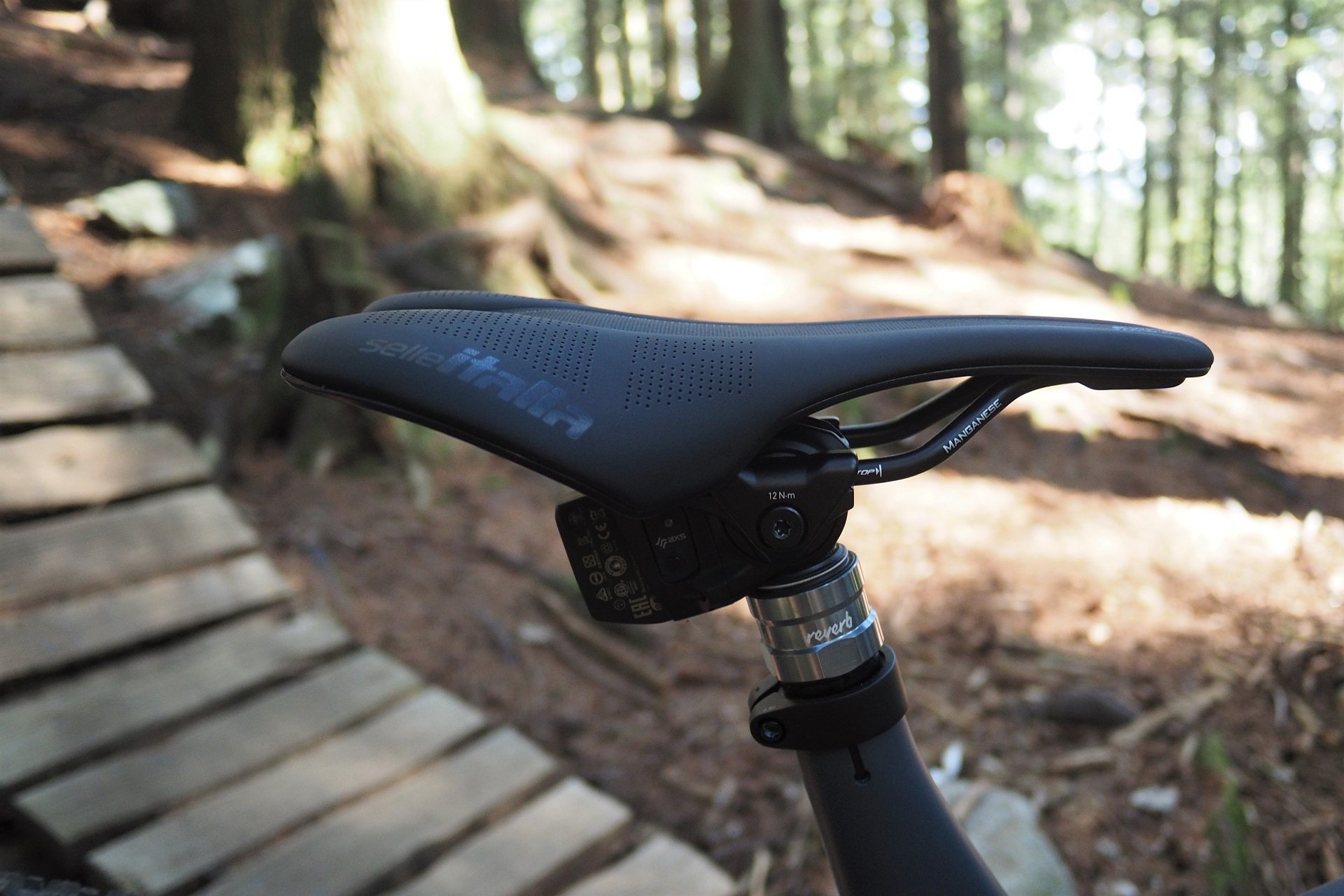
I don't have room for a longer dropper post than 125mm on the size large Canyon. From this angle that SLR looks comfy AF to me. (Photo: AM)
But Weight
I am going to post a scale shot of the Lux Trail, but this photo is the way I'm riding it. On top of my other changes, I added some OneUp Composite pedals. I removed the water bottles but left the cages, and then I came up with a total weight of 28.06lbs for a size large.
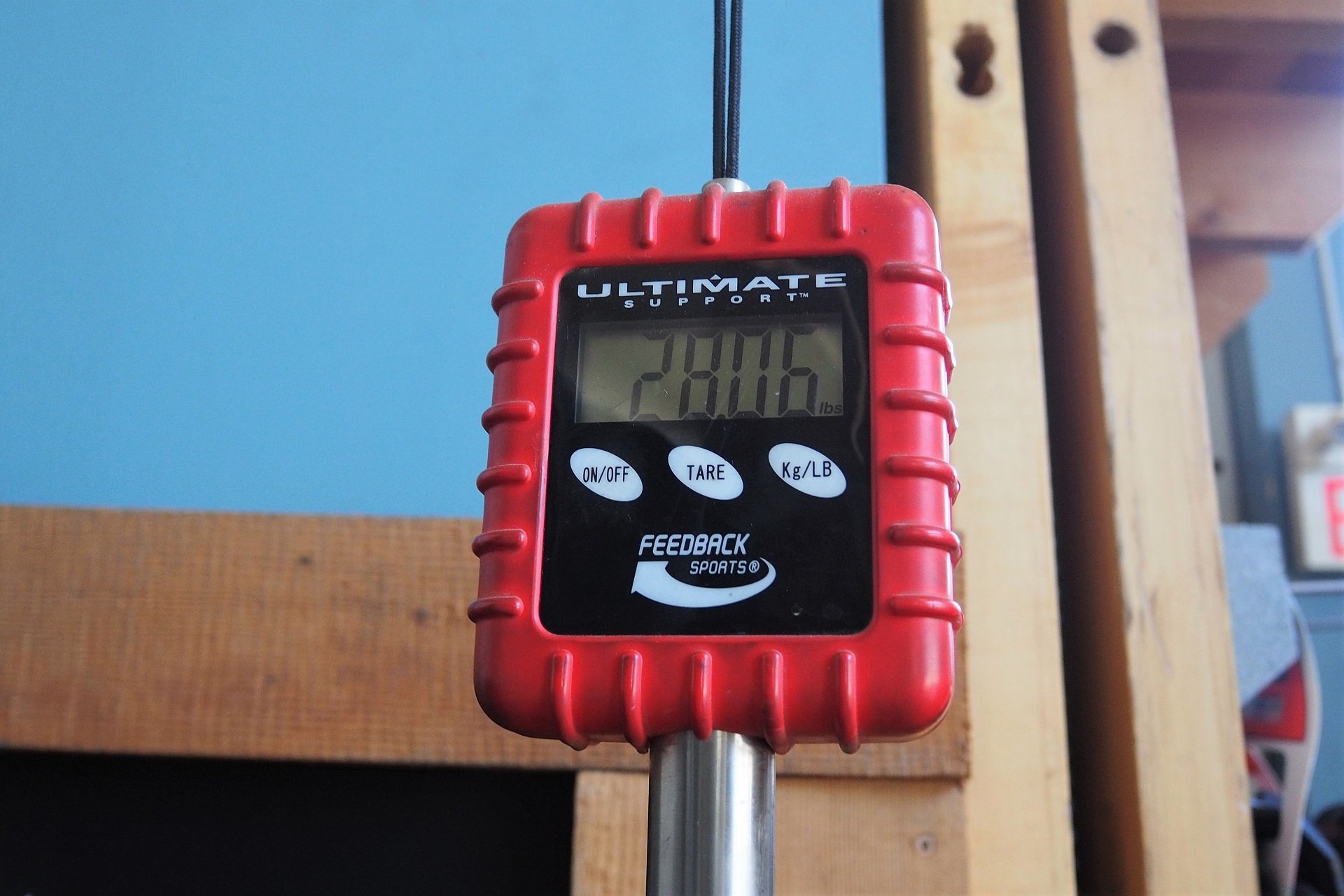
Out of the box, without pedals, Canyon claims 11.8kg | 26lbs without pedals for a size medium. That's probably accurate given my weight includes pedals and a DHRII (Photo: AM)
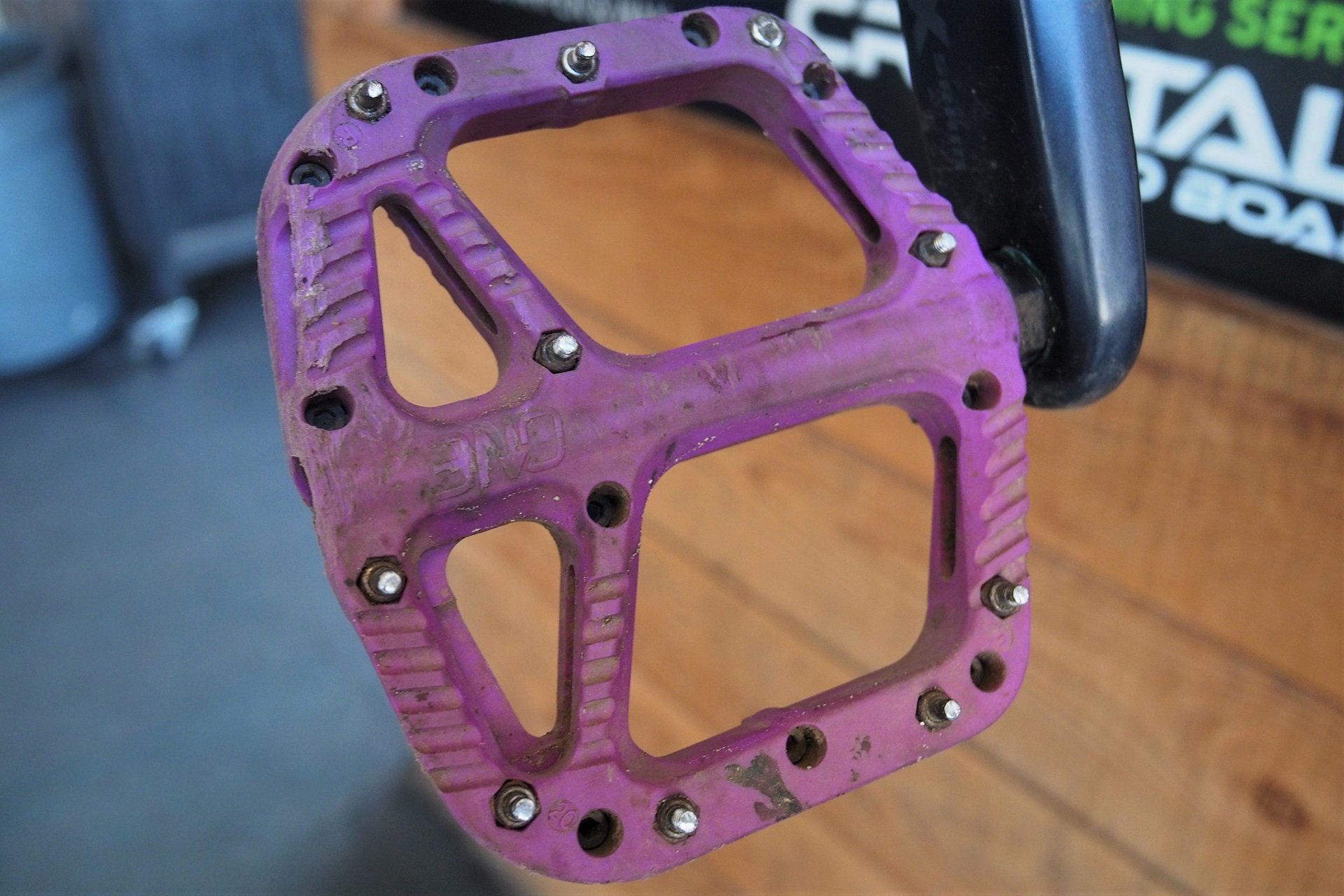
The OneUp composite has been my min-maxed measuring point for other flat pedals for a while. They're also fairly light. (Photo: AM)
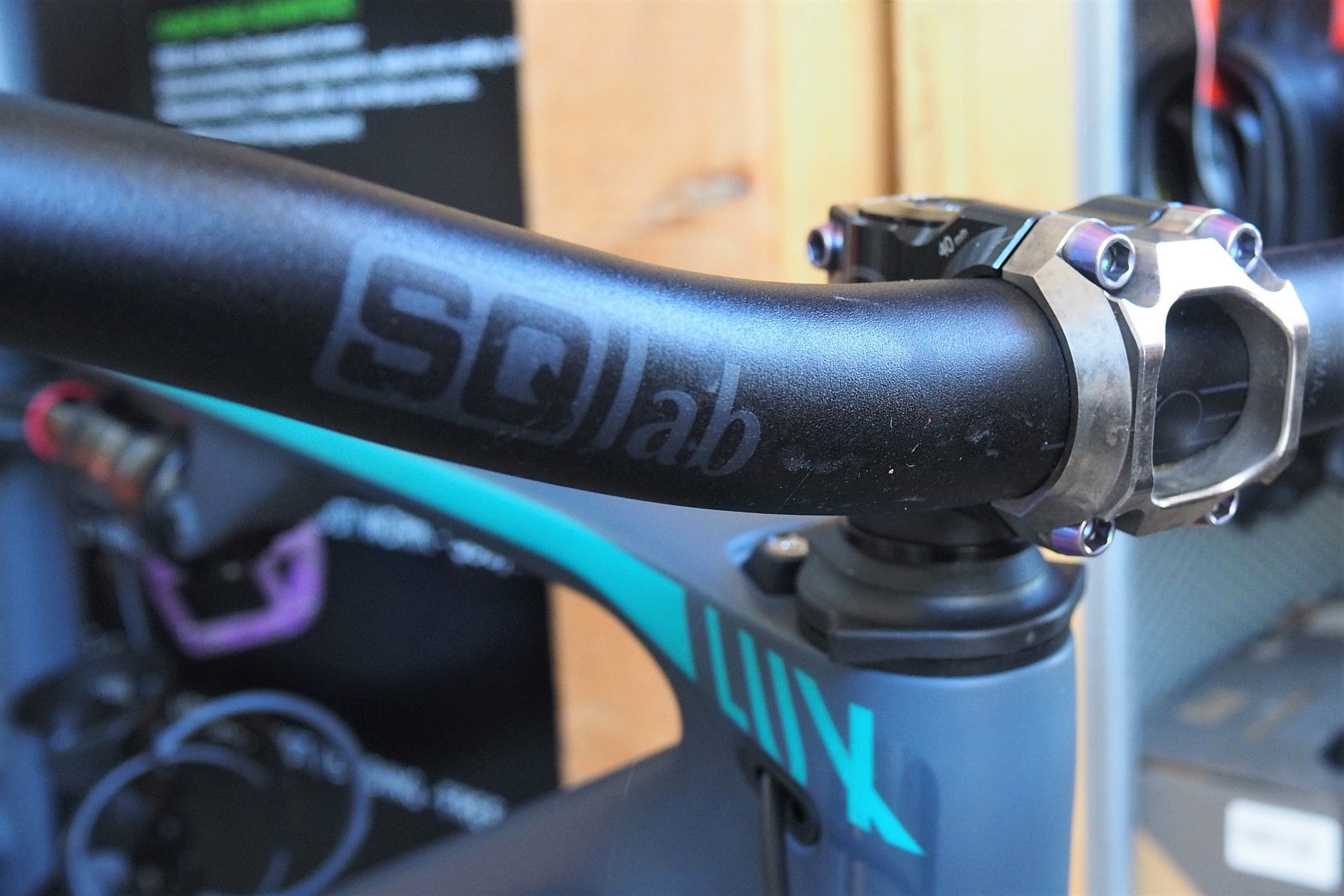
Aluminum replacing aluminum. The 40mm NSB Overlord is machined in Whistler, BC. I also installed my SQLab 16°, 45mm rise, alt-bar. (Photo: AM)
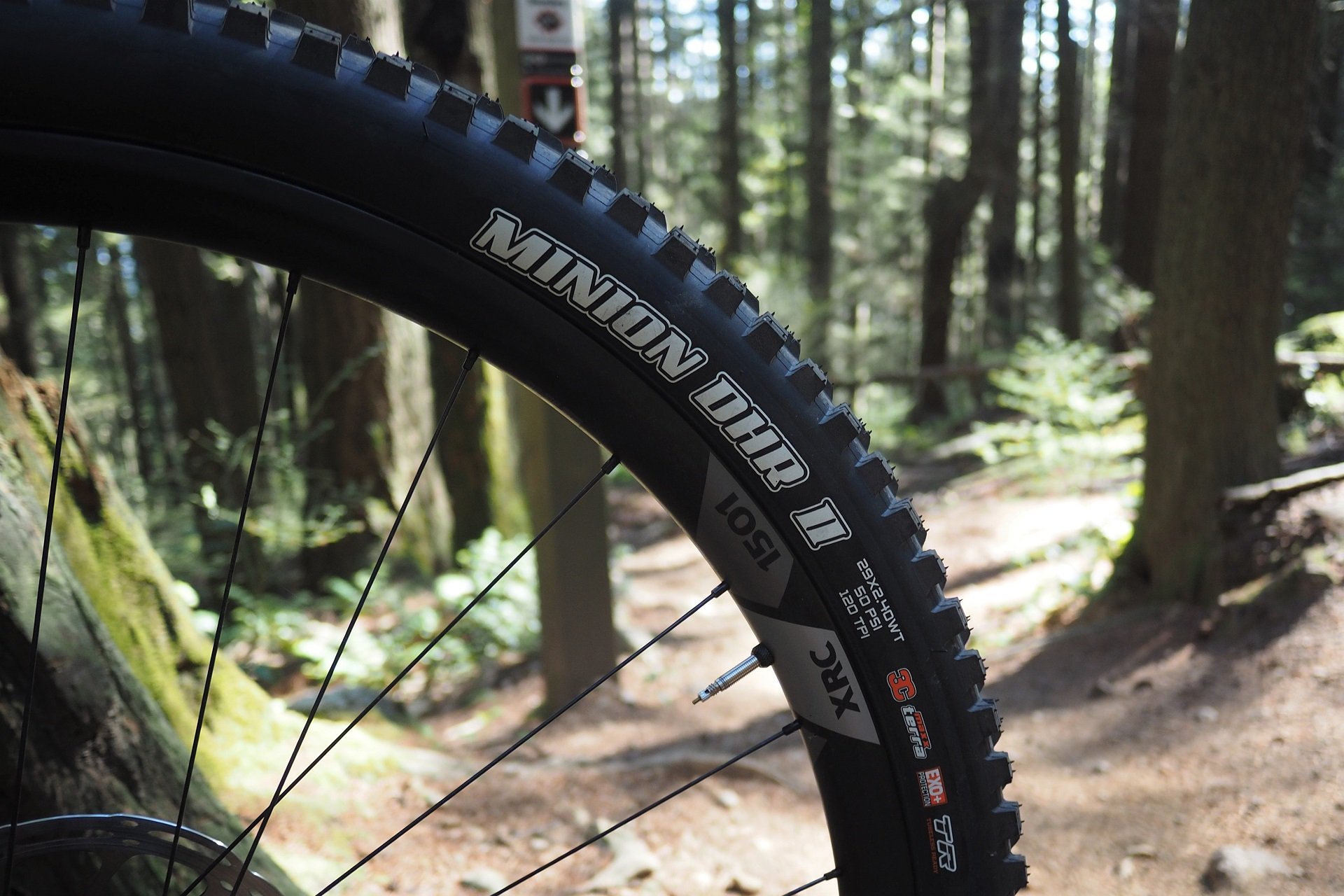
There's that DHRII shot again. The EXO+ MaxxTerra version of this tire isn't particularly heavy, but it certainly isn't lightweight either. (Photo: AM)
This Lux Trail really does fly. The pedaling position is great for delivering power to the pedals and on really steep climbs, where a steep seat tube angle may be great on an Enduro bike, I'm generally up out of the saddle anyway. My couple rides so far have included plenty of pavement and gravel, technical singletrack climbs, and then hard-enough descents that I feel I am getting the full measure of the complete package.
Lock Out SID
A lot of thought and effort went into making the Lux Trail a double-lock-out bike, whether in its Fox or RockShox suspension guise. At least with the AXS version, there are still the cosmetically correct four cables. On the other models of the Lux Trail there are going to be six housings - add the shifter and dropper - going around the headtube and that's busy.
The carbon front triangle is specifically shaped so that the shock lockout clears in an orientation that looks clean from either side. And that's why, unlike the ThunderVolt, I didn't just pull the lock-out cables and housing and ride the bike open for the duration of the test. I have used the dual-lock system on the road a bit and it adds to out-of-the-saddle efficiency on pavement. Anywhere else the combination of support and traction that the SID fork and Deluxe shock deliver is excellent.
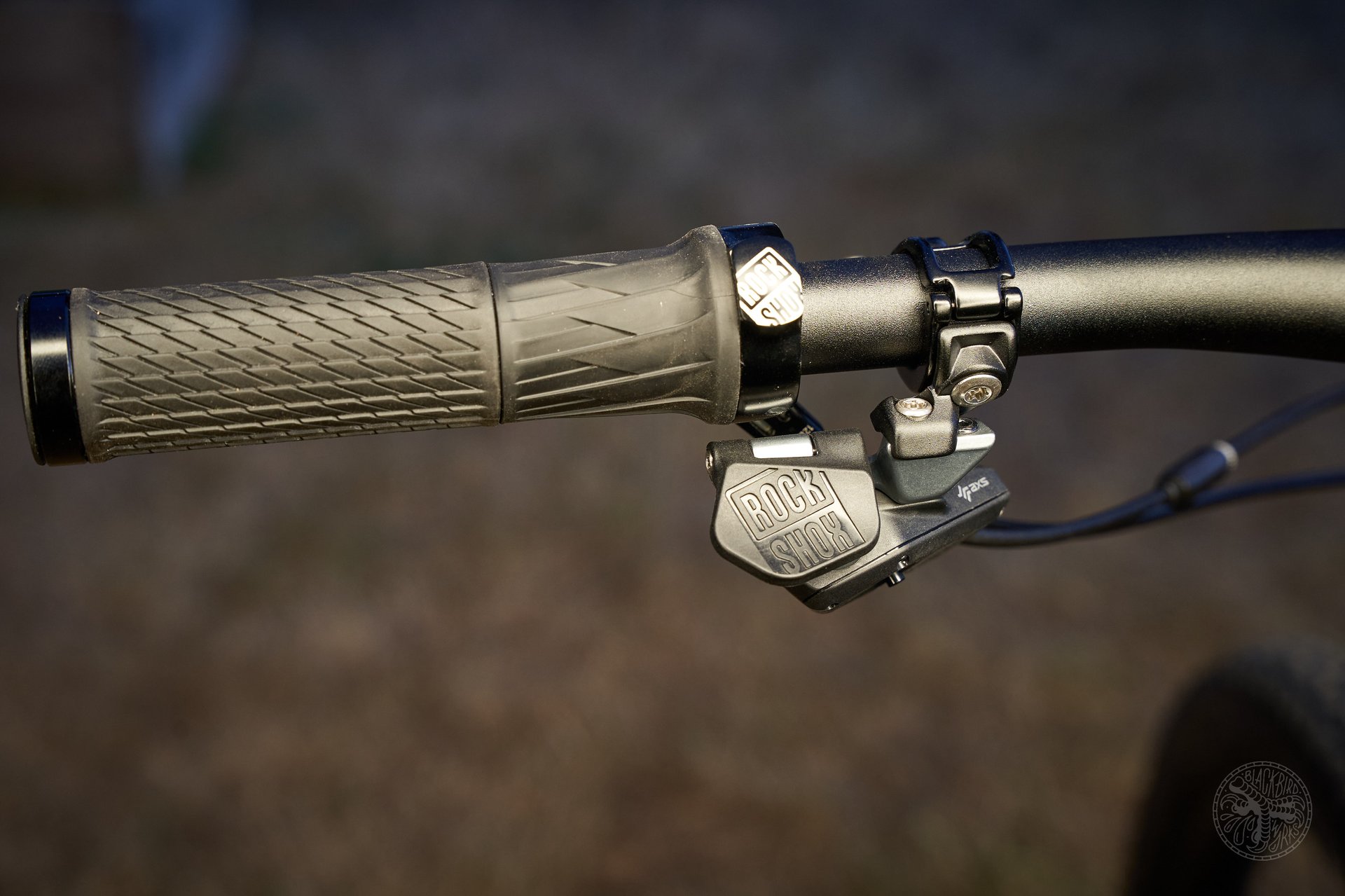
I was tempted to just remove the lock-out twister. The Lux pedals so well when it's all the way open. (Photo: AM)
The SID spec initially struck me as a bit strange - why not a Pike and a Deluxe? This suspension setup is heavily damped compared to any RockShox products I've ridden but on the trails, the performance-to-weight ratio is impressive. It's very early days so we'll see what the performance longevity is like but I'm surprisingly happy with the lightweight RockShox package.
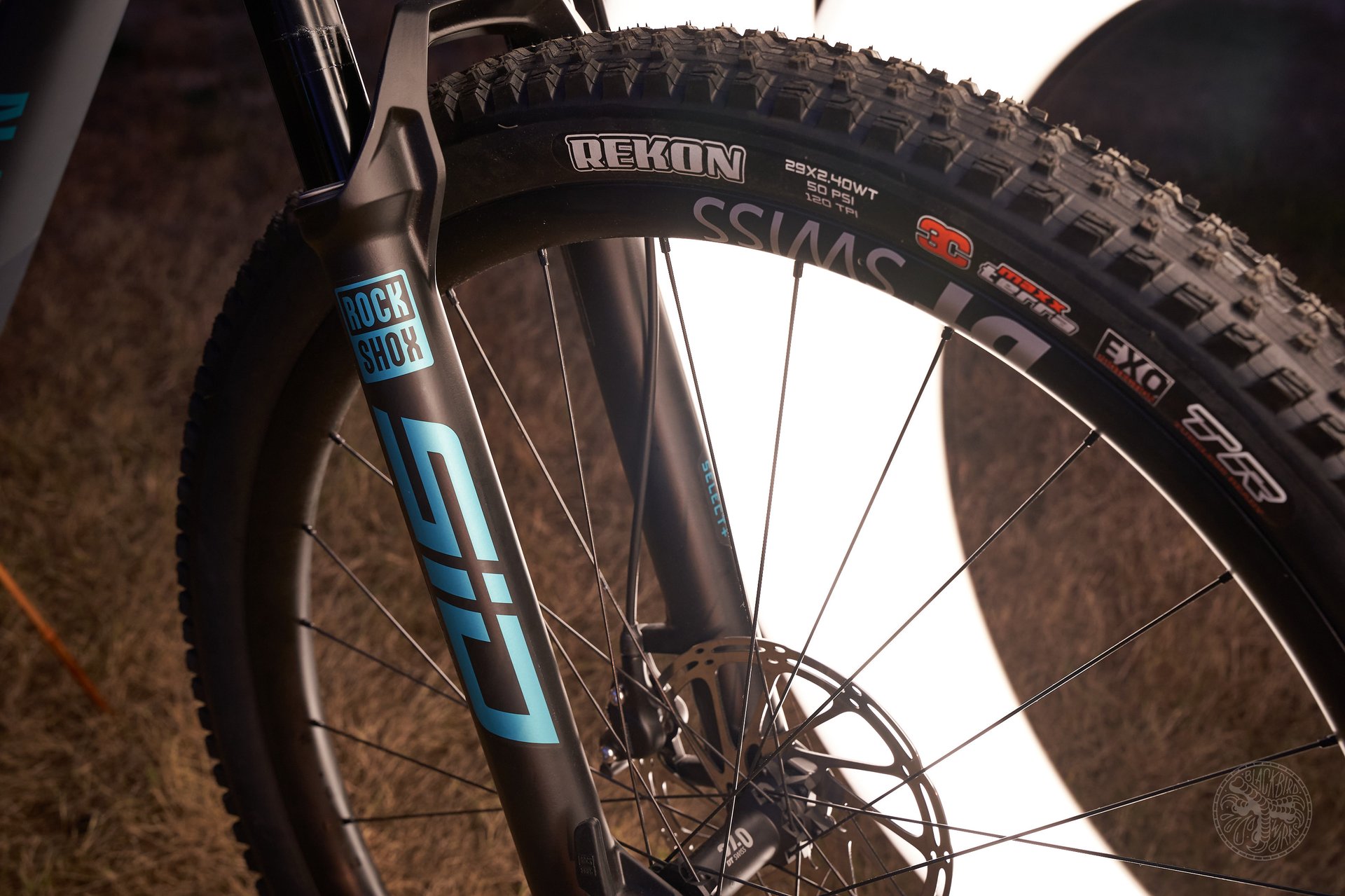
The SID Select+ combines a lightweight version of the standard RockShox 35mm chassis with their proven air spring tech.
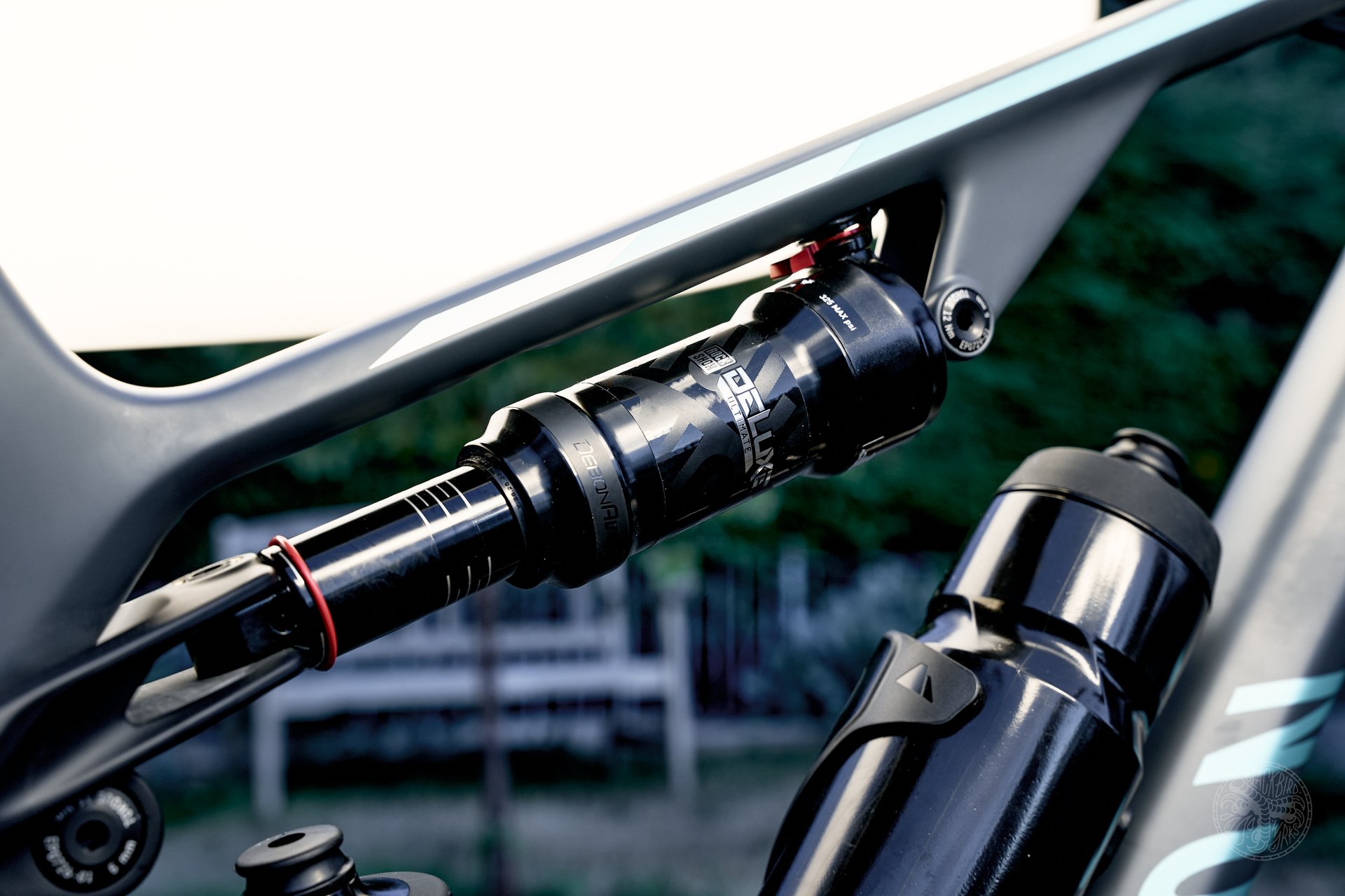
The Deluxe shock is tiny and holds about as much oil as the master cylinder on my brakes. It actually works well on the trail.
Boundary-ies
I'm very down with the aesthetic of this bike. Bumping into my friend Kim, riding up No Quarter on Fromme, she took a look at the bike, nodded, and said "it looks like a hardtail." It's a very classy, looking mountain bike that happens to deliver 110mm of travel in the rear. It also puts pedal power into the ground as well as any full suspension bike I've ridden. Now my goal is to maximize the descending experience without unduly affecting those ascending chops.
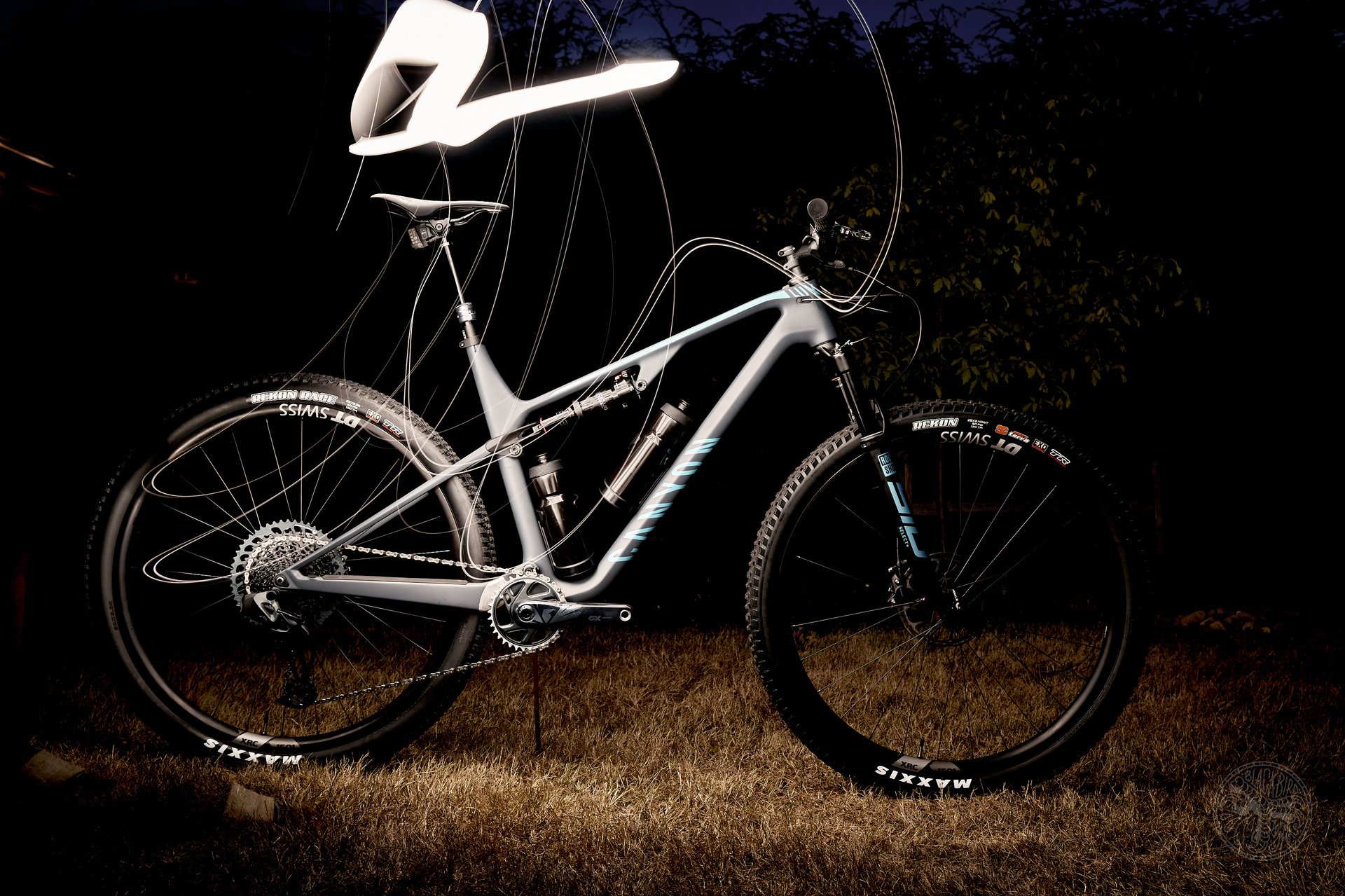
I had a really hard time selecting the title image so this is your chance to tell me if I did right by Deniz' art. This, #1, is actually my favourite.
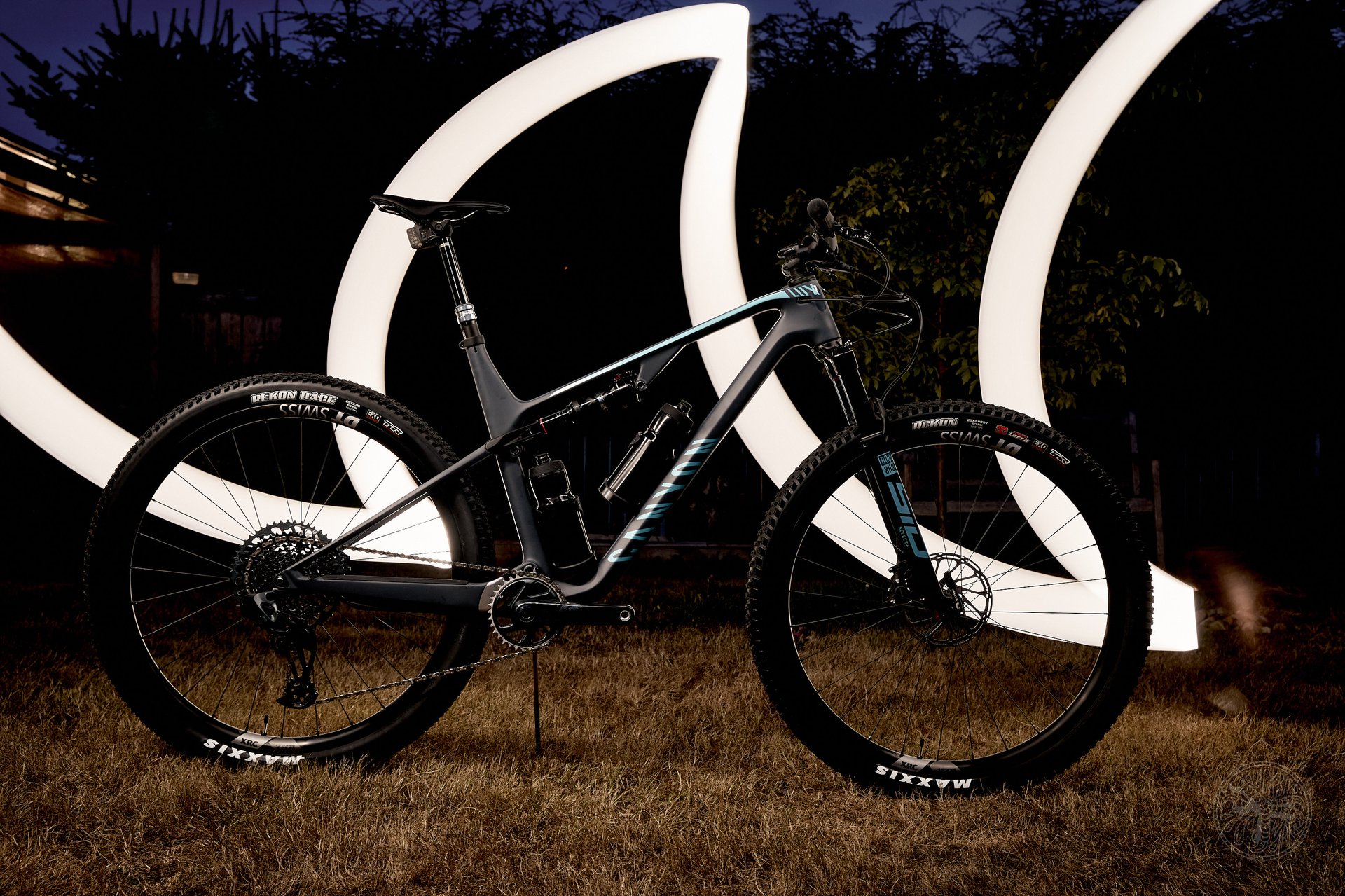
#2 is pretty freaking awesome as well. This was all done with a long exposure and Deniz dancing around the Lux holding a pair of lights.
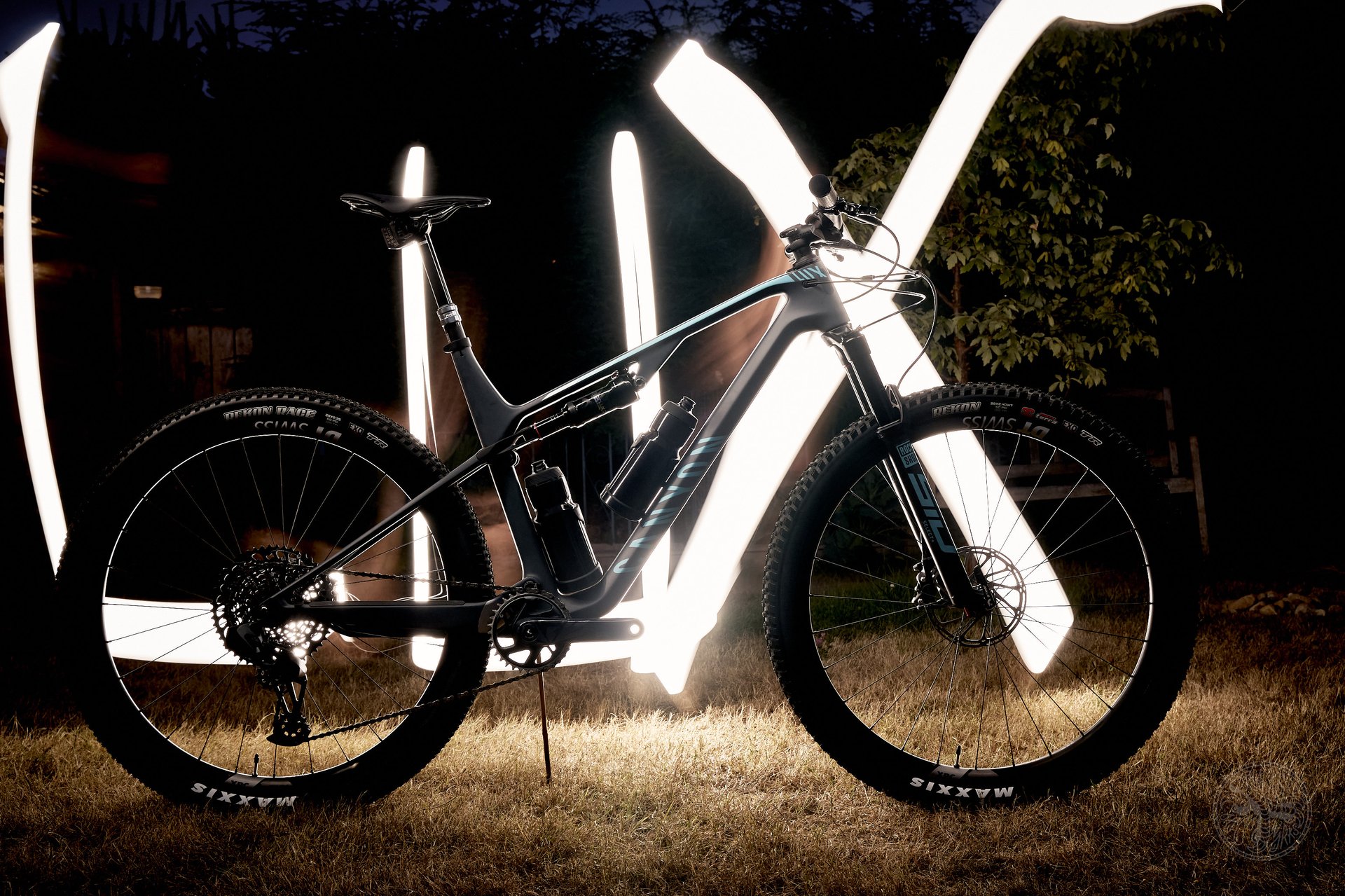
I chose #3 because he actually spelled LUX, backward, using said lights. There were a few takes to nail it. These were all from his first attempt with this technique!
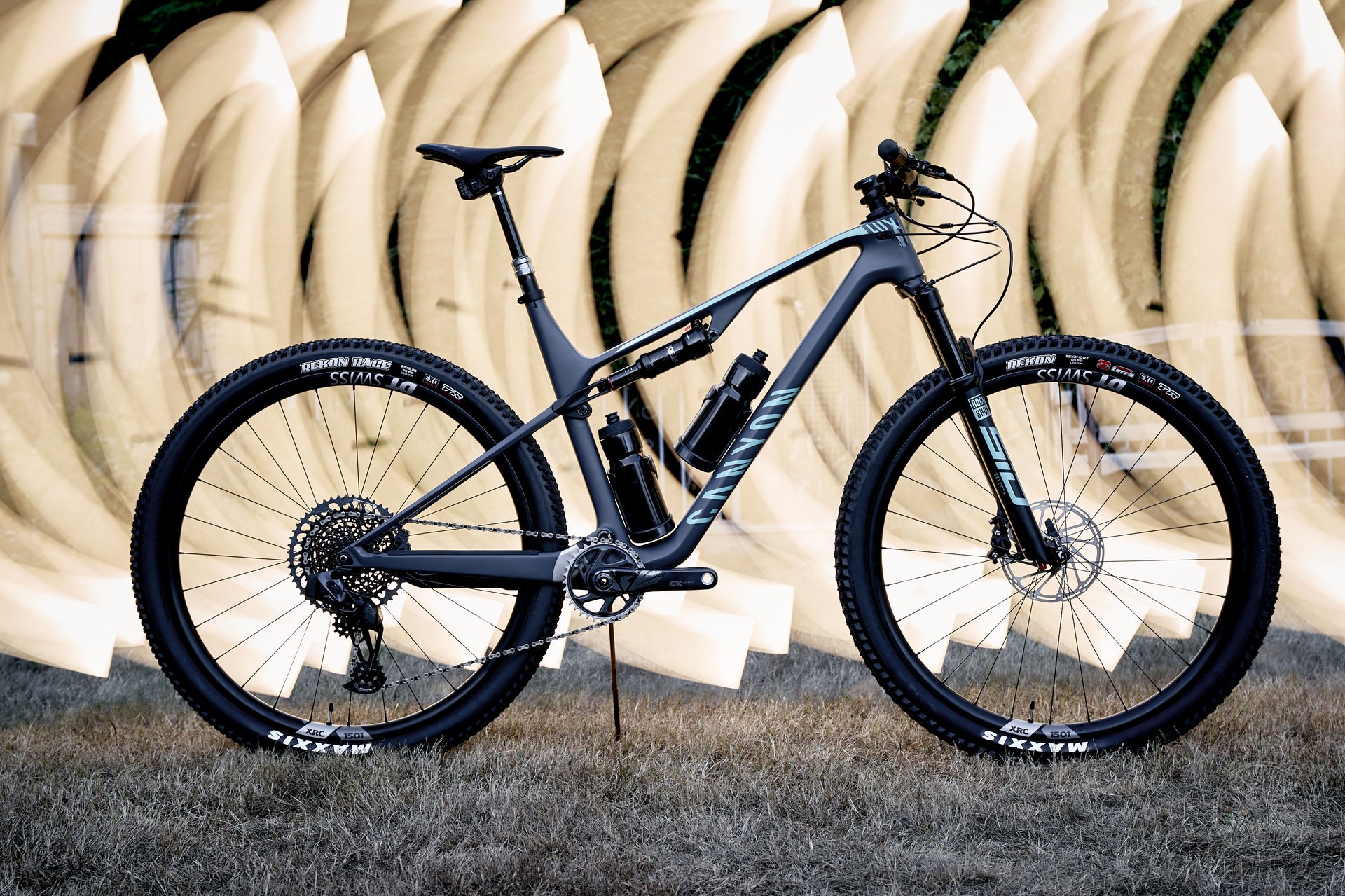
When I asked Deniz his opinion he was between #4 here and #3 above. Let us know which you like in the comments below.
For my very first ride on the Lux Trail, with those Level brakes still installed front and rear, I rode up from sea level to Fromme on a mix of pavement, gravel, and single track and then took it down Boundary Trail. It was great and I learned a lot of stuff right away. It wasn't my fastest or most competent effort but truly the brakes were the only thing holding me back. That's pretty impressive for a 110mm/120mm trail bike with a serious XC-lean and I'm looking forward to coming back once or twice and discussing where the bike and I have gone from here.
This Lux Trail is a hell of a bike for 7K CAD, about 5550 USD, especially considering the SRP of the DT Swiss XRC 1501 wheels represents about a third of the price. If you aren't decently handy with the tools then also add the cost of having a shop build it for you. It doesn't make sense to cut corners when buying a really nice machine you'll hopefully have for years.
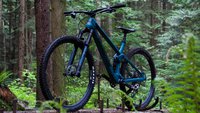
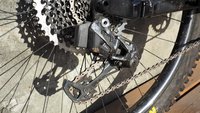
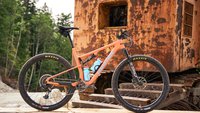

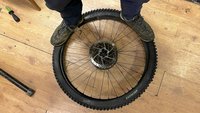

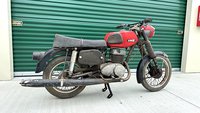




Comments
Vincent Edwards
2 years, 8 months ago
If we are bringing batteries into the mix, I’d love to see a wireless lockout system that unlocks suspension when you actuate the dropper.
Would it work for SRAM to use a remote like the AXS shifter on the left, where the lower toggle opens the suspension and actuates the dropper, and the upper button locks the suspension?
I like the photo shoot - feels spot on for the intent of this bike. #4 wins for me.
This bike is super tempting, as I’m missing my old Tallboy V3. This has very similar geometry at a lower weight and slightly more race tuned suspension platform. Back when I bought the TB3, Kona was phasing out the 111. The travel and geo were sooo close- it felt like buying the carbon 111 that Kona never made.
Reply
khai
2 years, 8 months ago
That's a really clever idea. One of the main reasons why I almost never use a shock lockout is because I tend to forget to unlock it at the top - so the first few meters of trail sucks and I have to pull over and stop top open it up. I can't say I'd be the target audience for an XC style bike with lockouts, but there have to be loads of dumbasses like me... ;p
Reply
Andrew Major
2 years, 8 months ago
AXS lockout would be amazing just in terms of ditching the extra cables. Tied to the dropper position? Yes please.
Reply
Andrew Major
2 years, 8 months ago
This comment has been removed.
kiwizak
2 years, 8 months ago
That seat tube length is criminal, 465 for the Lux in medium, is the same as the XL Process.
Reply
Andrew Major
2 years, 8 months ago
I don’t think it’s criminal in the same frame as the brake spec, but it is definitely a limiter in terms of who can ride the bike where.
I run a 170mm post on my tech-c hardtail so getting used to a 125mm is proving interesting.
More thoughts on that in the future.
Reply
khai
2 years, 8 months ago
It's a dealbreaker for me on a lot of bikes. Perhaps even moreso than the headset limitations. I wish I could fit a reach-adjust HS on my trail bike but at least I can run a 180mm dropper, which on a small frame is pretty awesome.
Reply
taprider
2 years, 8 months ago
How does your rear wheel not hit the back of the saddle at full compression? I know of a shorter person that has lost batteries from their AXS seatpost when the tire bottomed out into it.
Oh I know. You have an 85 degree seat angle with the saddle shoved fully forward on the rails. ;-)
Reply
Andrew Major
2 years, 8 months ago
I should have noted and will note in the final review, that the slacker STA does make it feel like more drop compared to a straight-up seat tube angle since the saddle is also moving forward. I like the bike-body separation of the long drop (I generally run 150mm-170mm) on my hardtail but rear-wheel clearance isn't an issue there.
I also know of a couple of folks who've lost batteries due to saddle/post contact. I've also met a number of riders experiencing "harsh bottom outs" or "shocks bottoming before full travel" where their wheel was actually contacting their seat.
Reply
JVP
2 years, 8 months ago
Ha! This talk of seat bottoming/buzz transports me back to the early '00s when buzz and busted seats were just part of the deal on the "big bikes" we rode. Good memories!
khai
2 years, 8 months ago
I've buzzed the back of the saddle on my DH bike but on all my other bikes it hasn't been an issue. Interestingly, looking at that particular saddle it seems that the rails are closer to the saddle base than some of my other saddles, and the shape of the back/way the rails terminate seems to allow it to sit closer to the wheel than others. I hadn't put much thought into that before (whereas I had considered the stack of the seatpost head) - but apparently rail-to-saddle clearance is also a thing.
Reply
Andrew Major
2 years, 8 months ago
It's not something that's usually a concern for me; however, I have ridden a few saddles that would limit my dropper post options because of how tall they were. For example, on the Titan, until I installed the OneUp dropper I had to think about pedal thickness and saddle-to-rail height.
Timer
2 years, 8 months ago
"but it is definitely a limiter in terms of who can ride the bike where."
But is that really a drawback? Pretty much everything about this type of bike is a limiter in terms of who can ride the bike where. Put on a longer dropper, shorter stem, mount an entirely different category of tyres, longer fork.... ...at some point you just have to admit that you got the wrong bike for your type of riding.
I wouldn't expect to see this kind of bike on the shore outside of the BCBR.
Reply
Andrew Major
2 years, 8 months ago
That’s why my goal is to change the minimum number of items - beyond standard cockpit preferences - and ride the bike on Tech-C terrain - I want to test it in riding situations that are fun on this bike. But also, I know plenty of riders tackling North Shore black trails on true XC bikes and I want to talk about that experience. I think, given where I ride my hardtail, I’m equipped to have fun using it for more aggressive downhill riding too but without changing so many parts that, as you note, I should just be on a bigger bike.
Reply
taprider
2 years, 8 months ago
I don't like short seat tubes. I would rather have more room inside the main triangle, and most of the time feel that 125mm drop is too much.
But I am the type of rider who is more likely to buy a bike like this.
Reply
Andrew Major
2 years, 8 months ago
That's a very good point in that most riders who would actually be buying this bike are going to care more about the two water bottles than they would about a bit of standover height. Especially given the HTA is more conservative than other bikes coming out with a similar purpose.
Reply
Andy Eunson
2 years, 8 months ago
I used to think that way too. But I went 150 drop on a bike and it’s very good. In my mind now I think go as long a drop as you can fit. No one says you have to drop all the way all the time but sometimes it’s great to drop a lot. It’s better for room in turns. Not just up and down.
Reply
Metacomet
2 years, 8 months ago
It is great that they fit two bottles in there, but it's more that the seat tube mast is unnecessarily long and inhibits the dropper length. Especially considering that the seat tube looks like it can accept a very long insertion depth. I just feel like with the omission of that design consideration, among todays competition, the bike is going to be quickly overlooked by people less strictly xc focused unless they are coming from a very similar xc bike.
Reply
Andrew Major
2 years, 8 months ago
I agree the seat-mast is an unnecessary obstacle to running a longer dropper. I believe that it’s a case of the front triangle layup being borrowed from the Lux CF race bike - where it isn’t an issue - that has just been lengthened and slackened a bit.
Reply
khai
2 years, 8 months ago
I think the complaint is the part of the seat mast that sticks up above the top tube. It doesn't need to be that tall, especially with a nice long/straight seat tube below the top tube. I can't quite tell if the shock mount interferes with seatpost insertion but on this frame design that's simply inexcusable.
Reply
Andrew Major
2 years, 8 months ago
Agreed on the mast - see comment straight above.
The linkage doesn’t interfere with insertion depth. I’ll put a longer seatpost in to confirm but insertion should be unrestricted.
Reply
doodersonmcbroseph
2 years, 8 months ago
I always thought V-brakes were fine in dry conditions :) but I don't weigh much I guess. That being said my current bike has XT 8120's lol!
Deniz, the light painting really works here!
Reply
Andrew Major
2 years, 8 months ago
Yeah, I'm not going back to V-Brakes on a mountain bike anytime soon either. The Level is closure to the performance of V-Brakes in the dry than it is to four-piston Shimano brakes.
Reply
DBone57
2 years, 8 months ago
Why the love for 6 bolt?
Reply
Andrew Major
2 years, 8 months ago
Without getting dramatic, my issues with CL are two fold. First, if your rotors comes loose riding there’s no way to tighten them. Second, if the rotors are run loose it’s the hub interface that wears not the brake rotor and that’s $$$. All that for what gain? It’s faster to change the rotors?
Most Centerlock rotors additionally suck because they can’t be trued.
Reply
Andrew Major
2 years, 8 months ago
On a more extreme note… my worst component failure ever was a Centerlock interface. Terrifying. #ThanksShimano
Reply
DBone57
2 years, 8 months ago
Interesting thoughts. I just switched to CL this year for the first time and love them. As for coming loose, that's a non issue for me as I am that guy who actually checks his bolts and psi before heading out for a ride (you'd love riding with me as I'm always 5 minutes early and my bike and kit are ready to ride), and for what it's worth the lock ring has never been loose. As for not being able to true them, I have no issues with that either as I true them at every tire change just as with any other rotor I have ever used.
Reply
Andrew Major
2 years, 8 months ago
I see things through a couple of lenses. I have had a CL rotor come loose on a ride that I know I cranked down and it really sucked - whereas with a regular rotor I always have a t25 - but it has only happened once. I also don't tend to bend/warp rotors much so straightening them isn't always a big advantage (although it is why I always buy solid steel rotors instead of the composite steel/aluminum ones).
On the other hand, wrenching in a shop I've seen a lot of loose CL rotors. With the 6-bolt running rotor bolts a bit loose isn't going to damage either member of the friction-loaded system, the hub or the rotor, and it is much more obvious that the rotor is loose (sound and feel). On the CL system, the splined interface does wear and in all the hub v. rotor cases, I've seen that now have an outsized amount of play in them it's the hub that's wearing. Replacing hubs costs a fortune compared to replacing rotors and my concern is once that spline interface is worn the rotors will continue to come loose (although I don't keep track of it in such a way that I can back that up with numbers).
I think it's important to remember that the rider who lubes their chain a night before the ride is the exception to the rule. In my experience, the average rider is more likely to have loose lock-on grips that throttle than to do any kind of routine bolt check.
Reply
Bikeryder85
2 years, 8 months ago
That chainline is atrocious! I love that you include that, valuable info for buyers....my pic is for #3; I really like night/dusk bike shots.
Reply
Andrew Major
2 years, 8 months ago
Thanks! Deniz did such an amazing job on the photos!
-
That chainline shot wasn’t meant to pick on Canyon or SRAM. Go shift any 12-spd bike into the low gear and have a really good, full, look. That’s the bailout gear, and I see a lot of riders on the Shore using it more than any other!
It’s even worse with shorter stays.
Rings are expensive yes, but a smaller ring is going to save most riders chain and cassette. And that’s most riders anywhere with climbs.
Reply
Jerry Willows
2 years, 8 months ago
even with a 28 tooth, most people would use the bailout gear because easier. Industry loves the shitty chainlines cuz more sales! /rant
Reply
Andrew Major
2 years, 8 months ago
I mean, it's still going to get used for sure but not ALL. THE. TIME. Plus, I wouldn't regularly see riders pushing their 12-spd 10-50/51/52t bikes up climbs that are doable on a single speed.
With the 34t on this bike, even with relatively low weight and fast setup, I've used that 52t more in two rides than I would normally use it in a month. Anyways, I'll report back but I'm definitely going to have to pick up a 30t for the bike so I can get 3-4 gear ratios into play on climbs and I'm decently okayish-ly fit/strong. I don't think it's out of the left field to be saying this bike should come stock with a 30t.
Reply
Bikeryder85
2 years, 8 months ago
I agree, I run a 30t on a 9spd and I'm not very fit, but I have no issues (well maybe super steep climbs). Most people I ride with are always amazed I can even climb on the thing, it's kinda strange how people's perceptions have changed. It's almost as if you *have* to run a 50t cassette now; I mean I get it if you want to xc race and run a bigger gear, but for people like me who are just finding ride time between jobs and #dad-life a smaller ring is a no brainer.
Reply
Andrew Major
2 years, 8 months ago
I've been working on a fairly long-running series of articles called 'Does The Future Have Fewer Gears' that deals with this exactly. I'll take bigger jumps, better chainlines, and fewer cogs any day.
I'm due another entry for my 1x setup that I ran at the end of my Titan experience and on my Yeti SB104BBR project.
delarscuevas
2 years, 8 months ago
Canyon does not state the chainline, but considering the tyre clearance, I would't be surprised if it were 55 mm. That's 3 mm's worse than a 52 mm Boost chainline.
My Spectral 29 has a 55 mm chainline as well, shimmed back to 54 mm. With aftermarket E*13 cranks.
Reply
Andrew Major
2 years, 8 months ago
It's not on the spec list and I didn't measure it but I'm 100% positive it's a 55mm chainline. With a smaller chainring I can probably swap out to a narrower chainline at the same time but for a lot of carbon shapes it just comes down to clearance (Yeti) or you end up with a minimum chainring size (Rocky Mountain).
Reply
ackshunW
2 years, 8 months ago
Ooof ouch. I’m also on 9 speed , 142 spacing. But I achieved perfect-center of cassette chainline with a little fussing about. That’s ~45mm!! What’s perfect center of cassette on 12 sp boost?
Reply
Andrew Major
2 years, 8 months ago
I’m not sure where perfect-centre is on a 12spd Boost 148 setup.
delarscuevas
2 years, 8 months ago
Thanks. On second though, I am slightly doubting my own previous suggestion about the 55 mm chainline though, because this would mean that the rear triangle is redesigned as well. But since the tyre clearance on the Trail is bigger than on the Lux, it might be the case. I hate it when manufacturers don't state that kind of stuff!
Reply
Andrew Major
2 years, 8 months ago
Canyon provided a ton of information but chainline isn’t in the package. It may also be different depending on build - ShiRAMano.
I’m putting together a some questions for their pm for the LuxT so I’ll add that to it. Might as well get the definitive answer.
Andrew Major
2 years, 8 months ago
The stock chainline is 52. Going to play with the possibility of moving it inboard with a smaller ring.
Reply
delarscuevas
2 years, 8 months ago
Thanks. 🙂
Reply
Andy Eunson
2 years, 8 months ago
It does look bad. But in my experience with SRAM it’s a non issue. Shimano 11 speed it was a drop issue during a backpedal. I find with 12 speed that I use more of the cassette so wear is more even. When we ran triples we tended to use one or two cogs with the granny. Three or maybe four with the middle ring and similar for the big ring. Around here we rarely use the biggest gears off road. Maybe a bit on road though. Longevity of XO1 has been stellar. On on my fourth season on one cassette and four chains. Waiting on my Unior cassette wear tool to see if it needs replacement. It may be time. I did a ride the other night up Babylon By Bike. I used that 50 tooth by 32 ring most of the way. Lost a kilo in sweat. Pulse maxed at 187 and I’m 63. I get annoyed at people telling others what gearing they need. That’s a terrain specific and individual thing.
Reply
Andrew Major
2 years, 8 months ago
Eagle: I’ve not seen any of the chain dropping issues that came up with Shimano 11-spd (and some SRAM 11-spd) but I see a lot of worn 50/52t cogs, chains, and rings with otherwise pristine cassettes that informs my belief that, at least in the Shore-To-Sky region, many riders are over-geared.
The jump to the 52t over the 50t also doesn’t shift as nicely.
I’ll stand by my claim that a 34t is too big a stock ring for this bike and a 30t would be the better spec choice for more riders.
Reply
Andy Eunson
2 years, 8 months ago
I ran a 34 last season with a 50 low on 27.5. This year I had to go 32 because I lost a lot of fitness or something. Certainly where we all live a 34 is too much for all but the skinny racers. 30 or 32 makes a lot more sense.
Reply
Andrew Major
2 years, 8 months ago
I think it's just that a lot of brands are adding the 50t v. 52t into the calculation and that's where the one-size-up chainring is coming from. But it's a false lower gear because the rest of the cassette cluster is identical so it means spending a lot more time in the 52t than the rider would have with the 10-50t cassette and a smaller chainring.
I went up +2 teeth on my chainring when I mulleted the Titan at first so I'd buy a 32x10-50/52t for 27" and 30x10-50/52t for 29" as the optimum stock gearing for the average rider. My most significant point on the subject is just that brands should be treating the 10-52t and 10-50t cassettes as the same animal when choosing the ring size spec.
Reply
AndrewR
2 years, 8 months ago
And a well known cheap fix for riders who can check their ego and accept that they spec for the gears they use most of the time can switch to a non boost chain ring in addition to losing 2-4 teeth. Assuming that there is enough clearance with the chain stay that was designed with a boost chain ring in mind (it is a busy area of the bike).
There are certain race teams who switch to non boost chain rings as soon as the bikes/ group sets turn up.
The cheapest long lasting upgrade is the SRAM NX DM Non boost steel chain ring in 30T.
As a default XO1 cranks are specced with 32T chain rings and XX1 cranks are specced with 34T chain rings.
If their test tracks are flowy forest trails in Germany then 34T probably makes sense for them.
Reply
Andrew Major
2 years, 8 months ago
Yeah, my plan is to go inboard and smaller at the same time to get more usable gears and a better chainline in all the gears.
Interesting to know re. stock chainring sizes!
Reply
ackshunW
2 years, 8 months ago
Great first look, your lines about how this reminds you of mt bikes of old (eh, just gonna put a shorter stem and wider tires on this race hardtail, that should do it....) resonate with me.
And yeah the pictures are amazing, I love the wall of light one.
Reply
Andrew Major
2 years, 8 months ago
Cheers! Yeah, I readily admit that I’m more than a bit nostalgic for a simpler time when a mountain bike was a mountain bike. That is exactly how I use my single speed, so I guess I’m still on the program though.
Thanks for the photo vote.
Reply
khai
2 years, 8 months ago
I saw that Level brake and my immediate thought was "WTF__?!!!" I have a Level brake on my DJ and hate it. I can't imagine riding trail with those... I'd be curious to see how this stacks up against something like the Transition Spur. While this appears a little more XC (as opposed to "S2S/PNW XC") I think the intent is similar enough for a valid comparison.
Re: the bike pics I see why Deniz prefers #4. It may not be as "artistically interesting" as some of the others, it really pops. They're all good but I think #4 highlights the bike best.
Reply
Cooper Quinn
2 years, 8 months ago
I think of bikes on a spectrum, from left to right, of like... track-road-cx-gravel-xc-trail-enduro-dh, or thereabouts.
I'd say the geo (and tire/brake spec) plant this a bit to the left of the Spur, but they're definitely bikes you could be cross-shopping.
I've got a Spur review up, and a bit of a comparison to the Tallboy if you search the site here.
Reply
khai
2 years, 8 months ago
I agree with you on the spectrum as well as the placement. While I'm not sure I want a bike in that category they do intrigue me... Likely faster over rough terrain than my "hardcore hardtail" and perhaps more comfortable over a long distance - but at the same time I wonder if they're less capable due to the steep HA and shorter travel fork?
Reply
Andrew Major
2 years, 8 months ago
Certainly faster ACROSS technical terrain and up technical terrain. I can just sit a deliver power. My hardtail has the same travel but between the wheelbase and HTA it’s more capable on really aggressive terrain.
I had a dream last night where I somehow convinced someone at Canyon to furnish me a Lux Trail back end so I could ask Walt to build me a front end to closer match my V2. In my mind it was amazing.
Reply
Andrew Major
2 years, 8 months ago
I’d agree with Cooper that the LuxT has a more XC focus - just based on how much of the frame is carry over from the Lux race bike - but certainly it’s the same category.
My first draft had a lot more ranting about the headset choice. If they’d done a ZS/ZS setup then I could have gone -2* for this bike - putting me in Spur territory.
The Level brakes are awful. There’s just no nice way to say it.
Reply
Pete Roggeman
2 years, 8 months ago
I'm a big hater of the G2 brake, but I have Levels on the Blur I'm testing, and they've been great. To be fair I'm in Sechelt now, though, and the trails I'm riding that Blur on are not as steep or technical as what we have on the Shore. I'll definitely give it a good pantsing on the Shore to see how it compares over there.
Reply
Andrew Major
2 years, 8 months ago
Yeah, I'd swap you these Levels for some G2 brakes in a heartbeat. I'm not a fan of the G2 either, I'd personally run Codes, quite happily, on any and every SRAM-equipped bike but I think that for this bike Canyon would have been deciding between the Level and G2, and the Lux Trail is at least worthy of the latter.
This is not the first time someone told me they were fans of the Level (or relative fans of the Level) and I do agree they're the best SRAM brake in terms of the feel at the lever. Also, if you're running super fast XC rubber they're going to be easier to modulate than full-on stoppers, no doubt. I wasn't prepared to ride this dry-dusty iteration of the Shore on a Rekon/Rekon Race combo and the DHRII up front can handle a lot more braking force without barking loose.
I do think I've ridden enough examples on enough steep-enough trails that I can back up my experience without it being that I've received a Friday-brakeset so I'll be curious to hear your experience down, say, the original BCBR North Shore course: Severed Dick & Pipeline. I find that, like the M975, at some point no matter how hard you pull on the lever the brakes are locked out with a certain amount of pressure and that amount of pressure is less than I need.
---
Also, you forget to vote on a title photo! HAHAHA
Reply
mrbrett
2 years, 8 months ago
Photo #3 for me please.
Reply
Metacomet
2 years, 8 months ago
So, the Real question... 2014 Kona Process 111, or this new Lux? For myself if the intention was to find a fast but still fun and versatile xc'ish/trail'ish versatile and adaptable bike I think I would still go Process 111. That seat tube length would be the deal breaker for me honestly.
Reply
Andrew Major
2 years, 8 months ago
The LuxT wins on the modern Reach, bike weight, and room for +2 water bottles.
A medium LuxT would get me the same Reach as a large 111 and room for more drop AND, I don’t really mind the 125mm.
The only place I’d give the 111 a flat out win is that so can Angleset it. That said, it’s still my favourite bike of its era and I’d happily ride one today.
In the spirit of the 111 I would love to try a 140mm fork on the Canyon. I vastly prefer the 111 with a 140mm.
Reply
Kevin Bond
2 years, 8 months ago
I swore off press fit bb’s a while back after two bad experiences. I’m sure they’re better now, but please keep us updated if any problems. Also, is the shock stroke really 55mm? Interesting trend if so. The Exie has a similar leverage ratio.
Reply
Andrew Major
2 years, 8 months ago
It's a 210x55 delivering 110mm of travel, so an average 2:1 leverage ratio. I don't know if I'd be prepared to call it a trend, Foes pushed it for years on all their bikes from XC to DH but otherwise, I can't think of any brand that's marched to that drumbeat.
It makes a lot of sense in this case in terms of trying to keep the thimble of oil in the SIDLuxe shock was overheating and for a larger rider - like me - it should have a fairly bottomless feel without the frame/shock having to deal with a lot of forces from the system ramping up. It would be interesting to read a review from a light-and-lanky rider to see if they're having issues getting full travel without running excessive sag.
Reply
doodersonmcbroseph
2 years, 8 months ago
I'm willing to try it for you! I'm 6ft and 148lb with my gear on lol.
Reply
Kevin Bond
2 years, 8 months ago
By trend I mean trend of two. This Lux, and the Exie.
Reply
Andrew Major
2 years, 8 months ago
I should also note that turning wrenches in a shop, I've not had a bike with pressfit BB tolerance issues in some time now. Certainly, for a metal frame, I'll take a threaded BSA set up every day. But, for carbon frames, there are pros and cons between bonding in a threaded shell or just pressing in cups and I'd personally choose pressfit - I think.
Reply
JVP
2 years, 8 months ago
I’m with you on this. Threaded for alum, pressfit for carbon due to how many warranties there have been on the bonded aluminum inserts in carbon frames. Carbon cranks have the same issue.
Seems like the warranty issue on threaded carbon frames is getting better as the carbon factories in Taiwan learn how to bond aluminum better, but it’s still a place where there’s extra complexity, possible/probable failure, weight, and cost. On a pressfit, if you have issues you can just go buy a $100 Wheels Manufacturing thread-together BB and you’re good. It’s better for keeping frames alive for 10 years.
But yeah, you need extra tools for pressfit, so that part sucks for folks who don’t have a pro level shop in their garage like some of us. Again, Wheels Manufacturing to the rescue.
I say this on every freakin thread when pressfit comes up, mostly because I feel like there’s this big narrative against pressfit that came from a few frames with crap tolerances vs it being an issue of bad design.
And so goes my battle against throw away consumerism. Design stuff to last, even if it requires a compromise or two.
Reply
Andrew Major
2 years, 8 months ago
That's actually my biggest challenge reviewing any bike, never mind a carbon machine with a battery-powered drivetrain. When I'm not testing something for NSMB I spend all my time on a steel hardtail that I'll likely have forever (or until it breaks) as even though there are certainly some small changes I would make if I ordered a Walt V3, there's not anything I can see motivating me to go down that road.
When I get older I can definitely see the appeal of a full suspension single speed (with dual lock-outs) to replace my Walt, and a slacker version of the Lux Trail would be right up my alley.
Reply
Robert Vose
2 years, 8 months ago
I'm new to this site. This is a very well-written, useful review. It confirms I'm not shopping this bike. I've got a somewhat burlier Neuron which Canyon rates as Cat 3 (nothing over 60cm). That's nonsense on a 130/130 bike, but arguably a reality for this bike. That, the HT, the parts issues you note, confirm this bike is no spur, izzo, pick-your-favorite-dc bike......
Reply
Andrew Major
2 years, 8 months ago
Welcome and thank you! This Lux Trail is certainly to the XC end of the scale relative to the Spur, no doubt. If it was available as a frame-only and you built it and a Spur with exactly the same spec I think both bikes would be a lot of fun and it would be harder to split hairs. The geo is very close to a Kona Process 111 and that bike rips.
As to the Category 3 rating, I look at it holistically. Consider their category 4 rating which is an Enduro bike, but only for moderate jumps and no "North Shore" or "Bike Park" riding but also on their Facebike post is great for Whistler Bike Park. Anyways, if Category 4 is an Enduro bike (Category 5 is a DH Bike) then Category 3 is a Trail bike and it's both cool to have a sub-2000-gram frame that's trail rate and a 110mm travel carbon bike that's trail-rated, and I'd be shocked if Canyon denied a frame warranty based on any of the North Shore Tech-C riding I'm doing on the bike regardless of the letter of the law.
That said, I've added it to a list of questions for the brand for a follow-up article.
Reply
Robert Vose
2 years, 8 months ago
You're right about Canyon's warranty. I snapped a stay on an AL Neuron and despite telling them honestly that I routinely exceeded their Cat 3 limits, they gave me full value and a discount on a CF (which has burlier stays). And you're right that their marketing of, for example, the Spectral doesn't match its categorization. That's my basic beef with them. Maybe MVDP would have sent it if there wasn't a 60cm limit..... :)
Reply
Andrew Major
2 years, 8 months ago
Poor MVDP! I've been that guy trying to roll the drop and I can remember getting up and looking around to make sure no one saw me... so I can very much empathize.
Driving into an underground parking lot with your bike on the roof, or backing over it with your truck, or etc is not going to be covered under warranty, nor is obvious crash damage. But in my experience, most companies selling premium products give the benefit of the doubt to their customers when it comes to warranty.
Reply
Taiki
2 years, 8 months ago
I've been reading your articles for a while now and finally caved and made an account. I appreciate your writing and especially enjoy when you tinker with component and geo setup, whether for a review or a personal project.
This bike reminds me a lot of the Tallboy 3, which I've ridden many times and always enjoyed but never owned. I still think it would be competitive with the new crop of xc-trail bikes with some tweaks (9point8 Slack-R comes to mind).
Recently I've been on a '21 Stumpjumper that I got in a trade for a Phantom v3. It has blown away my expectations of flex stays and is just an incredibly versatile bike especially with a beefier 150mm fork.
I did notice the photos appear to show the bike equipped with a Deluxe shock, not the SidLuxe which is even slimmer and lacks a tool-free rebound knob.
Reply
Andrew Major
2 years, 8 months ago
Thank you! I have many tinkering plans for the Lux Trail so hopefully, this series doesn't disappoint.
I'm a big fan of the Tallboy and I think that every generation is worthy of a new life thanks to some over-forking, anglesets, and maybe some forward offset saddle or post play. Certainly, bikes are not evolving as quickly as the marketing of bikes is evolving.
The Stumpy is at the top of my list of bikes I'd like to long-term test. I feel like the combination of a slight over-forking and a mullet wheel would get me a STA that would be perfect for the application and the end result would be a lower maintenance platform that, for my skillset, would keep up to the Stumpy EVO and Epic EVO. Basically a perfect all-around mountain bike.
You are 100% correct that this is a Deluxe, not a SIDLuxe, which makes quite a bit of sense for the Trail platform thanks to the extra oil (updated / Thank You!). This shock has a rebound adjuster it's just tucked upwards towards the top tube. I need to bump it with a hex key as my fingers don't fit but someone with slender digits could adjust it tool-free.
Reply
oded1
2 years, 7 months ago
Hi Andrew,
I'm just wandering how at 5'9" (175cm) you feel at home on a Large frame.
I've been reading you were goin on a 40mm stem and a 16 degree swept back bar - But still sounds interesting on a Large size.
Canyon are listing 175cm on the Small sizing or the very low end of Medium and you are more happy on a Large ... ;-)
Just thinking why this difference happens? what is it that you wouldn't like on a Small to Medium size frame that moves you to Large?
Thanks very much for a complete and interesting review keep on.
Reply
Andrew Major
2 years, 7 months ago
Cheers!
In general terms, over the last five or so years, all the medium frames I’ve ridden have felt small where in most cases the larges have not felt too big.
Part of this is that steep seat angles really shrink effective top tube lengths (even some larges feel small sitting - Kona Satori was a prime example) and part of this is that local terrain is steep and technical and the body position between the wheels with a 40mm stem is better than with a 60mm stem. Certainly, to get most mediums to fit comfortably climbing I’m on a 60mm.
I find the 16° sweep SQLab bar my hands back a bit and can split the difference a bit, but it's more than just a change in the relative Reach so it makes less of a difference in stem length choice than most folks would assume. I'm happily running a 40mm stem + SQLab bar on the Lux but wound run a 30-35mm stem with a more traditional 7-9° bar on the Large. That's pretty standard for me on a modern large, though certainly if the average medium frame gets much bigger than for bikes without crazy steep effective STAs I could see myself on a medium with a 50mm stem.
Specific to the Lux, a big reason I went large is that the fit is very similar to my own custom Waltworks hardtail. My hardtail has significantly longer chainstays and a significantly slacker HTA, and doesn’t have the ridiculous seat mast, but when I sit on both bikes they’re instantly comfortable. I actually run a 1cm longer stem on the Lux with the same bar, which accounts for how much more the Reach grows on a hardtail through the travel.
The similarities to my own custom frame aside, the other reason I went large with the Lux is the wheelbase. With the relatively medium stays and the relatively steep head tube angle I knew there would be an extra degree of stability.
Personally, I think the only downside of the large is the seat mast. The bike would be more fun with a 150mm or even 170mm dropper.
Reply
IWY
2 years, 6 months ago
I’m looking at something in this category for 2022 (if there’s any availability!) and the sizing recommendations per the Canyon site confused me as well. At a hair under 6’3 with a 34 inseam it was putting me on a Large. I’m on an XL V2 Sentinel and my previous 2 modern geo Enduro bikes were XL too. Appreciate your thoughts on this, if I go the route of the Lux Trail I’m thinking XL?
Reply
Andrew Major
2 years, 6 months ago
That's tough. Most similar bikes I'd say you're an XL with zero doubts. I'm 5'9" with T-Rex's ape-index and other than the way-to-tall seat tube I've been enjoying a large. The XL has another inch longer seat tube over the large so it will really come down to how much drop you want to run.
I mean, and also the terrain you're riding. Tight, twisty, east coast single track going down a size and running a longer stem is going to work great. For the steep local riding I wasn't willing to give up the wheelbase to size down to a medium.
Hope that's helpful!
Reply
Dimitris Manargias
2 years, 6 months ago
Hi Andrew, thanks for the comprehensive review. It was great help! Regarding the chainring, did you swap the chainring with a 30t one eventually and did it fit without problems? I'm also thinking of changing it to a 30t on day one, but judging from the photos it seems that a small chainring would rub on the chainstays. Please advise!
Reply
Please log in to leave a comment.